#and it would further parallel Anakin because how does he come back?
Explore tagged Tumblr posts
Photo



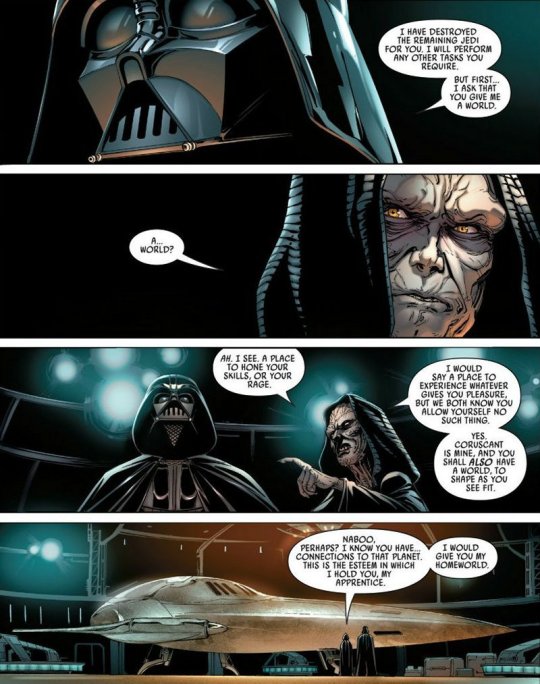
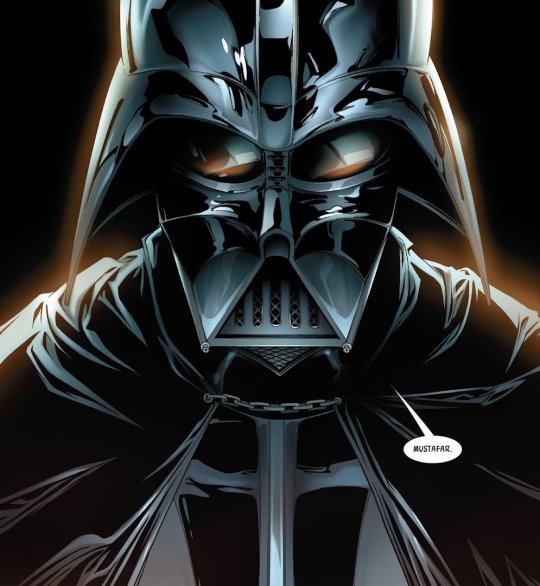


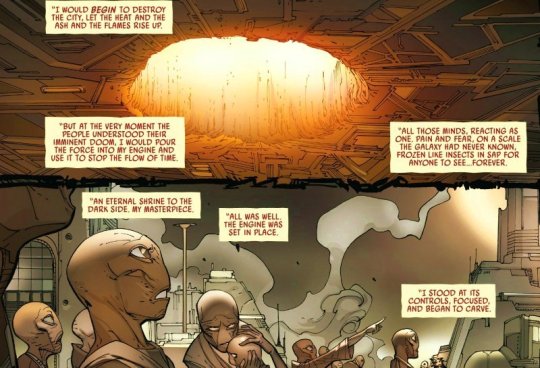
There’s a storyline in the Darth Vader: Dark Lord of the Sith comics, which is basically about an ancient Sith Lord called Darth Momin who haunts a mask and has information Vader wants about how to rip open the Force itself, and eventually we learn that Momin’s backstory is that he froze an entire city on the brink of destruction, so that their fear and terror would be frozen along with them, his shrine to the dark side. The entire comic is an excellent read when you look at the whole of it, it’s about all these paths being put in front of Vader through various encounters. In one issue, the Force puts a vision in his head where he could find Obi-Wan and beg him for help and Obi-Wan would lower his saber and listen to him. Or he could have remained true to the light and fought back against the dark, like Jocasta Nu did. Or he could have still fallen to the dark but found ways to still help the Rebellion further down the line, even if he was still doing terrible things, like Ferren Barr did. He could have taken the Barash Vow and removed himself from the conflict if he needed to find himself again, like Kirik Infil’a did. He could have walked away and started a family, like Eeth Koth did. It’s not just Darth Vader hunting down Jedi, it’s a story about him ruthlessly killing anything that suggests he could have chosen differently. Instead, in every instance, Vader rejects these possible paths and says the dark side is all there is. Instead, he asks Sidious for a world of his own to build a castle on and he wants Mustafar. He builds his shrine looking out over the point where he believes Padme died and Obi-Wan left him. He has done to himself what Darth Momin did to that city--he has trapped himself in a moment of terror and fear, holding himself in that moment forever, frozen in amber, never moving on from it. Darth Vader is trapped in the past by his own making. Now along comes the Obi-Wan Kenobi show. Those flashbacks we see are just as much from Vader’s point of view, that in part it may well be his connection in the Force with Obi-Wan and how his former Master still sees him as Anakin that is influencing the way Vader sees himself in these flashbacks, the 40 year old version of himself that’s not burned but is still a Padawan, but I think it’s also on some level a way to show us that Vader himself is stuck in the past. The parallels to those Jedi and Force-sensitives trapped in the amber in Fortress Inquisitorius, which is Darth Vader’s project, on a planet in his system, those people forever trapped at the moment of their despair. A gruesome shrine to the dark side, just as Momin’s shrine was. Just as Darth Vader’s Minecraft Castle of Bullshit and Loneliness is. When we see Hayden Christensen’s 40 year old face, at first it was a little jarring because that’s not what he looked like back then! But the more I think about it, the more this choice works for me, that letting his face be his face allows Hayden Christensen to actually act, it keeps it from the Uncanny Valley, and it does the perfect job of illustrating that Anakin Skywalker is 40 years old and still a Padawan learner, because he hasn’t moved on. He has frozen himself in the past and does everything he can to keep himself in that moment of despair and horror. He plays at being stronger now, having broken free from the rules of the Jedi, but we see him for what he really is. A sad man who refuses to move on, to let go of the fear and hate and rage, his need to prove himself and gain validation through others, who hasn’t truly learned to overcome his own weaknesses, to even admit that he has them. This is what the dark side does. This is what Anakin Skywalker has chosen. This is where Anakin Skywalker keeps himself prisoner to the the past and his own despair, agony, and fear.
#obi wan kenobi#obi wan kenobi spoilers#anakin skywalker#meta#reading comics: dark lord of the sith#long post
710 notes
·
View notes
Text
Victor Creel Theories
(also includes ST movie DNA series: Star Wars)
Victor Creel is described as "a disturbed and intimidating man who is imprisoned in a psychiatric hospital for a gruesome murder in the 1950s." We know he will be institutionalized at Penthurst mental hospital, where Peter Ballard works, based on leaked on set pics.
There a few possibilities regarding his character:
He could be a former test subject with some kind of powers and a connection to the upside down (which would also follow the even/odd season pattern of a main character being directly involved with the upside down creatures) I think it's highly likely that Victor Creel will be involved with the mystery/danger in Hawkins in some way, and have a connection to the upside down. He could also be disturbed on top of this, and he could be involved in Eleven's storyline this season.
That he is not a test subject and is ONLY mentally disturbed.
He may be related to one of the already established characters. Most likely Joyce, and maybe Terry but it's a stretch.
Before I go any further into that last possibility, I just want to preface that this idea of an "evil father/grandfather with powers" could be a purposeful Star Wars parallel. The Duffer brothers have already paralleled and used Star Wars references a few times in the show:

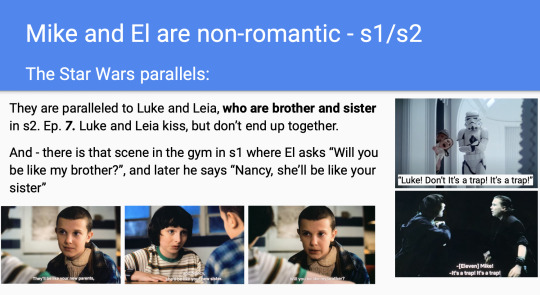
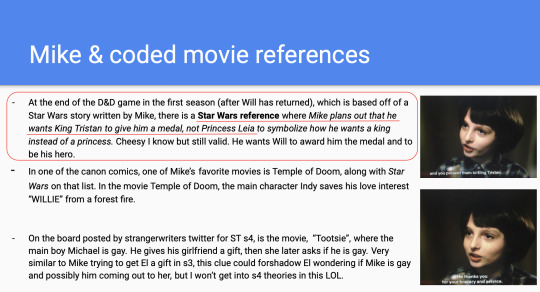
In Star Wars, Darth Vader is Luke Skywalker's father, and Palpatine is Rey's grandfather (aka the literal worst guy in the universe). A common theme in ST is abusive/bad fathers - that post here. Interesting...
Palpatine is also Anakin Skywalker's father, so Luke and Leia are both the grandkids of Palpatine as well as Rey is, but it's unclear if they are just force midichlorian related or actually dna related as well but I won't get into that here!
Luke and Rey are both force sensitive (have powers), so are Darth Vader and Palpatine; their descendants (kid/grandkid) have powers, and so do they (father/grandfather) The descendants use their powers for good, while the ancestors use their power for evil. Who has powers in ST? Eleven and Will - and they both already have this idea of abusive/bad/evil fathers: Will has an abusive father Lonnie, and Eleven has an abusive father figure Dr. Brenner "Papa".
So... Victor Creel being the evil/bad grandfather to either Eleven or Will and the evil/bad father to Joyce or Terry, would make a FULL Star Wars parallel to people who are morally good and have powers (Will and El - Luke and Rey), discovering they are the descendant of an evil male figure who also has powers (Victor Creel - Darth Vader and Palpatine)
If Victor Creel turns out to be the father of anyone in the show my bets are it's either Joyce Byers or maybeee Terry Ives.
If he was a test subject, its likely he went "crazy" with some of his powers and the government couldn't cover it up so they declare him mentally insane to get him committed, and he probably goes insane being locked away as well. Personally, I think he may be 001 or an early test subject, when they were still working out the kinks of the program, and I think he does have a big connection to the upside down.
The Duffer Brother's on s4: "In Hawkins a new horror is beginning to surface, something long buried, something that connects everything"....
Now let's get into the possibilities for Creel's storyline/who he could be related to (split into 3 parts).
Part 1: Creel could be Joyce's father
Based on Victor Creel's description as "disturbed" and that he is "in a psychiatric hospital", it could connect him to Joyce's bloodline.
There are several comments in the show hinting to this idea of mental instability in Joyce's family:
s1 ep.5: When Lonnie comes to visit in s1 after Will goes missing, Joyce says to Lonnie "No, don't look at me like that, like how everyone is looking at me, like I'm out of my damn mind" He responds saying "I think you need to consider the possibility that this is all in your head. Remember your Aunt Darlene?" Joyce quickly replies, "No, this is not that."
That conversation, although quick, is very telling. Lonnie is implying that Joyce had an aunt who was mentally unstable - and Joyce clearly knows about her aunt being unstable because she responds to his comment by saying what's she's experiencing is not that (the mental instability of her aunt)
s2 ep.2: Joyce says to Bob, "this is not a normal family", when he suggest moving out of Hawkins.
I used to think Joyce was always was referring to the whole 'my son got stuck in an alternate dimension with supernatural monsters and is now traumatized, and we were sworn to secrecy by the government' thing but maybe she is also referring to her biological family.
s1 ep.2: When they are searching for Will, one of the other police officers, says "Joyce is one step from the edge" and the other officer responds "She has been several steps for quite a while now".
If Joyce is related to Victor Creel biologically, and he did also happen to be a test subject, has powers, or has some other relation to the upside down, this could possibly have contributed to whatever kind of abilities Will has, because he would be a descendant of Creel. But Joyce does not seem to have any powers and neither does Jonathan. If they were related to Creel, it's odd that they both didn't get powers, but Will did. I've always thought Will was born with his powers, like El.
We know almost nothing about Joyce's past, it's never discussed in the slightest in the show, which I feel like is purposeful. We don't know Joyce's maiden name; she doesn't change it back after she and Lonnie divorce. Maybe the Duffers are saving Joyce's backstory for s4 (and possibly s5), like I think they are doing with Will and El's connection. Will, El, Hopper, and Joyce were pictured in a series of 4 tweets posted by the stranger writers, hinting to the main 4 storylines for season 4. My analyzation of this tweet here.
I think it's possible that Joyce's storyline this season could also have to do with her past- not just her searching for Hopper- but also more personal information about her. Perhaps we will see flashbacks of younger Joyce and maybe learn about her biological relatives.
Noah also said this would be the darkest season for Will, so this idea of being the grandkid of someone evil or disturbed could fit into that.
Part 2: Creel could be Terry's father/Eleven's grandfather
The only other person I could see potentially having a biological; relation to Victor Creel could be Terry Ives and Eleven, (because it would complete the Star Wars parallel mentioned earlier) but it's a stretch for several reasons, the main one being that Terry and Becky's father Bill Ives, died in a car crash (year unknown).
So for Victor Creel to be Terry's father that either has to be:
Her adoptive father OR
Her mother cheated and led Mr. Ives to believe Terry was his kid but her father is really Victor Creel, and Becky is actually Bill Ives son (which would explain why Becky has no powers)
Right of the bat it's interesting Terry's father's name is Bill. Bill is a nickname for William (Will Byers full name is William), and Billy's a nickname also for William... Hmmm....
Immediately after El is born, Terry is adamant that Brenner stole her child to use as a weapon to fight the commies BECAUSE SHE HAD SPECIAL ABILITIES - and she's completely right about everything. How does Terry know El had powers immediately after she was born? Because she knows she has developed some kind of special abilities from the experiments as well. When El goes to visit her mother in s2, THE LIGHTS FLICKER, just like they do when the upside down is near, but it's not Eleven controlling it. Her Aunt Becky says it's just the wiring, and Eleven responds: "IT'S MAMA. She wants to talk." And then we see Terry's NOSE BLEED, just like El's does when she uses her powers.
Quick side note about El's biological father is Andrew Rich: (It's revealed in the canon novel Suspicious Minds that Andrew Rich is El's father) He was a college student who got expelled from school due to protesting the Nixon address, making him eligible to be drafted in the Vietnam war, and he died in battle. Terry was involved in the Project MKUltra experiments at Hawkins National Laboratory in College, under the direction of Dr. Martin Brenner, but didn't know she was pregnant at the time. Andrew never even knew Terry was pregnant, meaning she was extremely early on in her pregancy at the time he was sent away, not even Terry was aware yet. It's also stated in this book that BRENNER HAD A HAND IN GETTING ANDREW EXPELLED SO HE COULD SEND ANDREW AWAY. The novel states that Brenner has Andrew drafted because he wants to SCARE Terry, to show her how much power he has over her life. There's definitely some history between Terry and Brenner that we don't know about yet.
If Victor Creel is in fact Joyce's father it's interesting that the powers seem to have skipped a generation with Joyce, and also one kid with the Byers, but if Victor Creel is Terry's father, no generations were skipped in passing down powers. ANYWAYS, this is all just theories and speculation since we have no actual concrete reasons to believe he will be related to Joyce or Terry.
Part 3: The possibility that Creel could be involved in Eleven's storyline this season does not rely on them being biologically related.
**One of the filming locations for this season is the Claremont House, which is RUMORED to be Creel's house and also "Vecna's lair" the new monster for s4 (unconfirmed) This is the house the Hawkins group goes into in the ST4 sneak peek, where they see the grandfather clock striking midnight. If that's true, there's a connection between Creel and the upside down and having powers, which could connect Creel to Eleven. The Duffers: "In Hawkins a new horror is beginning to surface, something long buried, something that connects everything". This thing "that connects everything", could be Creel's storyline (his possible connection to the lab/upside down/person in the show), because Creel's storyline also spans all the way back to the 1950's and before that, so there's our "long buried" part most likely.
Robert Englund recently revealed in *an interview* that his character Victor Creel gouges his eyes out, making him unable to see. Englund also mentions what it's like working with Millie Bobby Brown and talks about the first time her met her, he doesn't mention any other cast members in detail like he does Millie.
He's clearly working closely with Millie's character Eleven.
But why? I think Creel could be involved with Eleven getting her powers back, and her reliving her past. Once the government baddies realize El has no powers, they're gonna want them back. If Creel was in fact a test subject, maybe there is some kind of connection between them, Such as Eleven revisiting what happened to her in her past and how that could relate to her getting her powers back.
Another thought I had was that perhaps the gruesome murder he committed is somehow related to something that ends up impacting in Eleven's life.
------------------------------------------------------------------------------
Whatever Victor Creel's storyline is, it will be an important one, and it will carry somewhat into s5, since he will be a returning character. He is not signed as a series regular, but as a recurring character, which means we don't really know to what capacity he will be in s5. It could be flashbacks mostly, or he could have just as big or small of a role.
Source: indie wire

That detail about eyes being gouged out reminds me of fear street 1666 when the townsmen who was sacrificed to the devil becomes possessed and gouges the kids eyes out. Leigh Janick, director of fear street, is married to Ross Duffer. They both direct and make horror/sci-fi themed series about kids in a small town set in the 80's, who fight supernatural evil with a heavy undertone of queer themes, that are even filmed in a lot of the same locations (the mall, the town streets, etc.) I'm not saying it's the same thing, it definitely won't be. But there's so many similarities between ST and Fear Street, I thought I would mention this as another.
#stranger things#st movie dna series#st4#stranger things 4#stranger things season 4#stranger things 4 spoilers#stranger things season 4 spoilers#stranger things four#stranger things season four#victor creel#joyce byers#st4 spoilers#st4 theory#st4 speculation#Terry ives#eleven#el hopper#eleven hopper#Jane byers#Jane hopper#will byers#Will Byers has powers#stranger things theory#stranger things 4 theory#stranger things obsessed#stranger things analysis#stranger things 4 speculation#stranger things meta#stranger things season 4 theory#st meta
60 notes
·
View notes
Text
The Mandalorian: Is He “Better Vader”?
This may sound funny, but please hear me out for a moment.
The further I watch Star Wars’ new live-action tv show, the more I get the impression is that Mando is meant to be a positive version of Darth Vader (the “dark father”).
Father figures usually don’t have a thankful role in this galaxy - either they are absent like Anakin’s, terrifying like Luke’s, or well-meaning but failing in their primary duty of keeping their child safe, like Ben’s.
Not a few fans, though a little mockingly, like to call Kylo Ren “better Anakin” since his conflict is more fleshed out and the whole figure inspires more sympathy. My theory: is Mando meant to be “better Vader”?
It was repeatedly and amply shown that the cause for the never-ending conflicts in the galaxy lie for a large part on the side of the Jedi, whose stuck-up attitude ultimately failed. Their order prohibited personal attachments, and even the wisest among them were not affectionate. This was what drove the all-powerful but passionate Anakin, who desperately wanted to have someone he could love and protect, to his ruin: the moment he finally became a father he also became a ruthless monster. Mando is introduced as a merciless bounty hunter, but as he opens up to the child, he becomes kinder and begins to find friends. He grows even more valiant, but also learns how to be gentle and caring.
Since the Jedi are almost all extinct, but Force-sensitive children still are born throughout the galaxy, we are left with the question of what is to become of them. Some were brought to Luke’s new temple later, but we can assume that not all were identified.
Mando’s little protegee is staying and making life experiences with a guy who doesn’t know anything about the Jedi and has no clue of the source of the child’s mysterious powers, but instinctively does the right things: he keeps him safe, instructs him, scolds him when necessary, and offers him friendship and companionship. (The Mandalorian who adopted him probably was a good father figure, too.) The child never sees his “father’s” face, but nevertheless he trusts him explicitly. Mando is the living proof that coolness and fighting qualities are not opposed to being gentle and caring.
Ben Solo’s tragic fate was the result of failed fatherhood: Luke did not know how to be a father because he had no children of his own and had had no role model, while Han did not trust his capacity to protect his son from his own powers.
The Parallels
Both Vader and Mando are soldiers. Though not Force-sensitive, Mando is extremely strong and well-versed in martial arts; he never shows his face; he wears an armor completed by a black cape which does not seem to have much practical use. He usually speaks only in short, clipped sentences and has a wry, sarcastic kind of humor.
Vader was a follower of the Emperor, factually a slave who had no choice but to obey his master, and wherever he went he wreaked terror. Mando does take jobs from the bounty hunter’s guild, but essentially, he is a free man and often offers his services negotiating on his own terms. Noticeably, he fights against raiders and mercenaries or remnants of the Empire, peace following in his wake.
When he first reaches out for the baby, it looks like the opposite to another famous scene in the saga: here we have the adoptive but good father, while the other was the biological but cruel father. Luke did not take his father’s hand, while the baby instinctively reached out to the man who had protected him.
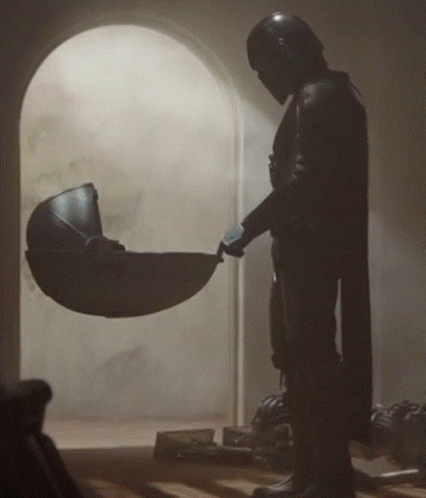

Note also the scenic reversal: one figure is standing on the right side, hand with upturned fingers reaching out into a void, the scene is bathed in cold light. The other figure is standing on the left, hand reaching down, illuminated by warm light.
When we do see his face once, Mando is lying down and helpless like Vader; he is not disfigured though and despite being injured, he is not dying. Shortly after this he finally accepts his task as the child’s father figure, while Vader died a few minutes after his unmasking and could not fulfil his fatherly task any more. Also, in both cases we learned the person’s real name not long before the mask went off: Anakin Skywalker respectively Din Djarin.
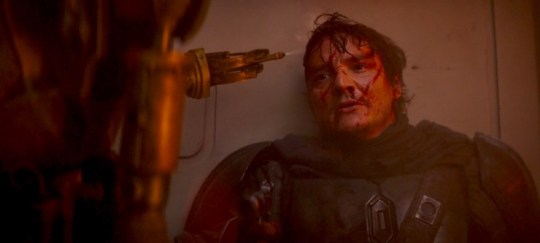
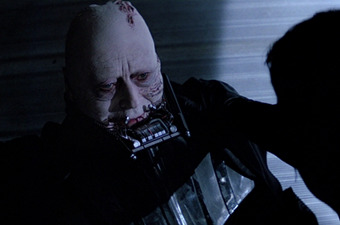
Given the saga’s love for cyclical narrative, this would make a lot of sense. Star Wars is telling us once more how important a protective and kind father is for a child, both as a role model and an attachment figure. We do not know yet how baby Yoda will turn out; but it would have made little sense for the storytellers to think up such a figure in the first place if they didn’t want him to go another (possibly better) way than his more famous predecessor.
Is the galaxy at last healing after the terrible conflicts caused by both Jedi and Sith, and will the good fathers be responsible for a better future, maybe even for the long-awaited Balance in the Force? I hope so.
May the Force be with the Clan of Two. 😉
(On a side note: Vader / Anakin was in his mid-forties when he died. Din Djarin is about the same age.)
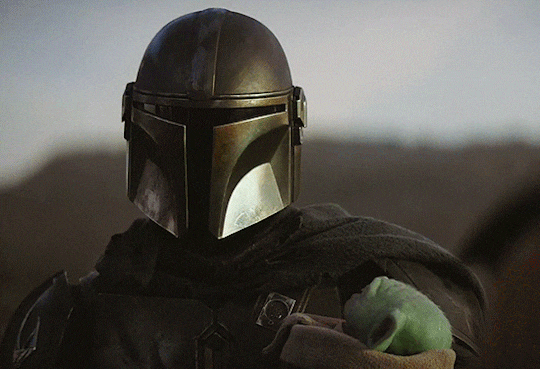
After the closure of Season 2, I would like to add a few details that also set Din Djarin apart from Anakin.
Attachment vs. Affection
Anakin’s greatest weakness was his anxiety to lose the ones he loved. In the end, he sacrificed all of his ideals for the purpose of saving his pregnant wife. Luke also loved his friends and wanted to save them, but in that fateful moment before Palpatine, he realized that he would have had to give up his integrity for the purpose, and that was when he decided to throw away his weapon.
Din suffers deeply when he has to give up “his” child to a literal stranger for an indefinite time. However, he knows that it must be done because he does not have the knowledge to train him. Grogu also, reluctantly, lets go when he sees that his “father” is doing the same. This goes to show, again, that he is much stronger than Anakin.
Following Rules vs Following One’s Heart
Like Anakin / Vader, Din takes his helmet off the moment he has to say goodbye to his child. The famous sentence “Just once, let me look on you with my own eyes” comes to mind. Vader was a Sith Lord and Anakin had been a Jedi. Both adhered strictly to their code: Anakin was a faithful Jedi until he became a Sith and Vader obeyed to the rules of the Sith until for a brief moment he acted like a Jedi again (and, also, like a father, which was a first). Mando unmasks not only before Grogu but also
- Luke, who is a total stranger - Moff Gideon, an enemy - Bo-Katan, a possible potential enemy since she pursues the Dark Saber - Fennec, an ally but not a friend - Cara, a friend who never saw his face.
That he is willing for all of them to witness the moment he lifts his incognito shows that Mando is finally listening only to his heart. The Way of the Mandalore, which was his guideline for his entire adolescence and adult life (i.e. thirty years or more), has become less significant to him than the bond he has with Grogu.
Anakin’s tragedy was that he could not follow his heart but that some rules defined by an outside source always were in control. He wanted to be a husband and father and loyal friend, a mechanic and a pilot, not a Jedi or a Sith.
Ben Solo’s tragedy was the same; though not born a slave, he also had no choice about what to do with himself and his life. It was either being a Jedi or a Sith. But we know that he wanted to be a son and a lover, and a pilot.
The same fate occurred to Luke, many years later: the kind-hearted, affectionate young man from Tatooine, who so easily befriended everyone and always was compassionate and helpful became aloof and detached on being a Jedi, because he thought that was what this task required. But in the end, it was exactly what made him not understand and even fear his nephew, with disastrous results.
Din Djarin chose the way of the heart, he is no longer adhering to “the Way”: he said himself that now he can’t put his helmet back on. (Alternatively, he could put it on again, but that would mean defying the Way otherwise.) Grogu has witnessed that a man can very well choose family over a code that was taught to him, even if he adhered to it all of his life. Luke is the one who carries him away, but Grogu looks over his shoulder to his “father”. Luke may become his teacher, but Grogu’s role model, his hero, will always be Din; as it was for Ben with his father Han.
Hints at the Future
Anakin died twice: once on Mustafar, where he also lost his blue light sabre, and on the second Death Star, where he had lost the red one. Din Djarin, at the end of this part of this journey, receives a sabre, although he never wanted it.
With the Dark Saber, a new fate is awaiting Mando. Is his destiny that of being the warrior-king, protective and honorable, that ought to have been Anakin’s place? Maybe. As they say, the best leaders are the reluctant ones. 😊
#star wars#sw#read more#the mandalorian#mando#din djarin#baby yoda#anakin skywalker#darth vader#luke skywalker#han solo#the Jedi#father figures#clan of two#kylo ren#ben solo#greef karga#grogu
392 notes
·
View notes
Text
🚨The Rise of Skywalker Detailed Review and Spoilers Ahead🚨

George Lucas: “If the boy and girl walk off into the sunset hand-in-hand in the last scene, it adds 10 million to the box office”
The “fairytale” we got: A long long time ago in a galaxy far far away, there was a curse of pain and death in a family that just went on and on. They were never able to break it and they all die, the end.
Well, you did it JJ, you little punk...you ruined 40 years of cinema. Kids are coming out of theatres crying, they can’t understand. I guess this was the “fun and hopeful ending” you were speaking of during the press tours. Are you on crack or something, or just sadistic....why would you promote it like that!? Did you forget Star Wars at its core is a story of hope, light, a fairytale in space for children? They did it...they united Reylo’s and Fanboys through hate.
JJ you do realize tragical romances are only tragically romantic if there was romantic buildup? Romeo and Juliet married in secret, Anidala did as well and flirted in the fields. How was this supposed to be satisfying? A five-second beginning, middle, and end. How this went through multiple execs is beyond me.... I would have understood if Reylo was Rian’s creation. BUT JJ LITERALLY was the one who told Rian to go forth with it...he created Reylo so you can’t say the last Jedi derailed things on that front. JJ wasn’t brave enough for his own vision. This movie was like “the crimes of Grindlewald”, a lot of stuff happening that made me feel nothing.
Okay, first things first. The OG trilogy was necessary, the prequels were necessary to set up that Vader did not start off bad. What was necessary about the sequels? They just dismantled everything the Skywalker family worked for. Why did we have to see ALL of our favorite characters die? Was the aim that a villain can only be redeemed through death? How original. I’m convinced what they were planning for since force awakens was a journey from villain to hero...but instead we got this a 10min redemption resulting in death a la Vader. Why call Adam Driver’s character a “Disney Prince”?When did Happy endings become so controversial? We go to the movies to feel hope, to escape reality...George Lucas understood that. JJ’s trilogy is uninspired, bland and contributes nothing to the saga. JJ went as far as to recon his own “The Force Awakens”.It had the chance to define generations but no. Literal and utter garbage. Rian made some odd choices but he was bold, unafraid and had the vision. HE knew emotion was at the heart of Star Wars.
WHERE DID THE SKYWALKERS RISE? MORE LIKE RISE OF PALPATINE, HE BLOODY WON
BUT my problem is not with the ending, it’s the bloody entire movie. This movie made me realize that it's not Reylo that I am a fan of, it was Ben, Leia, Han, Ani, Padme, and all those other characters. I’m upset because this movie is not my Star Wars: of family, love and above all else hope. This is just a 2.5-hour video game with no emotions. This trilogy was all angst with NO payoff.
Okay, you will never ever convince me Palpatine was planned the whole time. This whole movie was retcon for the Last Jedi that pissed off the fanboys. Lucas films did not have an outline for the three films and Rian derailed whatever they wanted to do....except they didn’t even tell him what they wanted! This should be a cautionary tale of why you need to plan. Kylo ain’t bad, Snoke is gone....well pull out Palpatine I guess. This whole film is JJ’s mad scrambling. Alright, I will humor you, tell me how Palpatine came back when he fell down a shaft and exploded....not *boom boom because of force*. The force in this movie is not canon George Lucas force, it’s just an easy out whenever JJ wants one.
1. Opening Crawl: As soon as I saw this I knew all the leaks were true, I wanted to bolt from the theatre. When I saw them in August I laughed cause it was so ridiculous it couldn’t be true. How could Disney let a whole movie leak? The plot seemed like a bad fan-fiction. Actually, fanfics are way more true to lore. Anyway, so Palpatine “announces” that he’s back. Is this the shrewd Chancellor Palpatine we know? Certainly, not...why in the world would he announce it rather than keep on the DL and just attack. Yo Palps ain’t this dumb why would you let them (the resistance) prepare?? Because of plot...well okay.
2. Did Last Jedi even happen: this film is the sequel to the force awakens, like TLJ never happened...except it’s acting like there was some movie in between that JJ made. Okay, so why is Kylo trying to run Rey over with his tie fighter...he doesn’t really want to kill her. It’s just meaningless action shots. And don’t get me started on exposition, the dialogue: “hey look its the Knights of Ren”. Except they do nothing. Cool cool. Kylo’s character goes back to Force awakens era like no development had occurred...except he’s not even there he’s just messing around not even being a real villain. JJ’s specialty is set-up and he does this beautifully....but he can not wrap up and follow through.
3. Rose Tico: yup last Jedi never happened, she has nothing to do. She and Finn are irrelevant. Finn has reverted to being obsessed with Rey. Cool Cool. I honestly feel so bad for the lovely Kelly Marie Tran. How did you relegate a relatively big character into the sidelines?? Why introduce two new characters this late. Rose could have filmed in for them...but alas we must snub Rian at every turn because that’s just how petty JJ Abrams is. ( don’t get me wrong Jannah was cool)
4. The Rise Of Poe Dameron: Finn has been relegated to a side character who does nothing and just yells “REY!”. It was a great setup, a stormtrooper who was force sensitive but doesn’t want his life to be fighting for nothing. You could have explored trauma, the discovery of the light but nope nada. Tell me the point of his character journey. So flat and static. And with Jannah and the ex stormtroopers they could have gone with the arc of these lost, sad kids coming together to find family.
5. Leia: Okay you’re telling me our Princess would give up on her son before he was born, just throw away her lightsaber and accept Ben’s fate? Cool alright. And she knew about Rey Palpatine and didn’t say anything...my princess would never.
6. Mary Sue Rey: Ahh Rey this girl feels no emotion in this movie...just like the audience. Sure she’s trained but she can just do stuff with the “force” that even Jedi masters can’t. Stopping a whole starship, something even Yoda could barely do...yup she can do it. Beat Kylo all the time except one, yup she can. Manipulate the force in mind-boggling ways, heal people...sure Luke couldn’t but Rey certainly can. Cause she is the chosen one...hell even Ani wasn’t this talented and he had years of training. Poe and Finn have a genuine connection, Rey just seems disjointed (totally understandable why)...but if so the ending is even worse. She doesn’t even find peace with her friends. She’s not realistic and human like Luke and Leia were.
Force sensitivity in the galaxy: What a perfect setup, the boy with the broom at the end of TLJ that was force sensitive. The message is that the power to use the force was spreading through the galaxy. No longer confined to the elite. People were hearing of Luke’s battle of Crate and rising.
7. Kylo/Ben: I still maintain that he, other than Ani was the most nuanced character in the whole saga. His arc from Force Awakens to Last Jedi had progressed. How great that even someone from the legendary line of skywalker and solo could fall to the dark again. He wasn’t flat, he was a tortured boy that was conflicted since the first movie. How great would it have been to see him as a conflicted supreme leader, which was set up in TLJ. But *gasps* a plot of his very own, no can do, this is the nature of JJ’s crush on Rey and Daisy.
Disney released comics that made us sympathize with him, to see that all along he was manipulated by Snoke, and Palpatine the voices in his head. Neglected by those who were supposed to love him. Adam Driver was cast perfectly, he had almost no lines that weren’t related to Rey’s charcater arc. If he were a woman I’m sure everyone would be offended. That single line’s delivery “Dad-”
Come on Poe had more lines than him, and Driver according to JJ was half of the protagonist. He was pitched an arc opposite that of Darth Vader that’s why he signed. Man JJ really did do everyone dirty.
8. Ben had no lines while redeemed other than “ow”...I am so sorry ADAM that this nasty ass JJ did this to you...this part was 100% improv by Adam, I am willing to bet my life on it. You know why “ow” was brilliant? Cause it meant he felt pain and emotion, he was no longer hiding behind the hardness of Kylo REN. Adam’s performance as Ben left me speechless, he was convincing as Kylo, intimidating...but as BEN he shines in the way only Solo’s can. The way his eyes become determined once he accepts he must give his life, and he does so happily for the love of his life. His soulmate. Star Wars and JJ never deserved the talent that is Adam Driver.
9. They are supposed to be equals in the force yet they missed the opportunity to fight Snoke together. Tell me how they are equals. He existed only to further Rey’s plotline.
Oh and the other Jedi including Anakin whisper and help Rey...when his own grandson has been asking for help in distress for like 30years. Nice real nice.
10. Finally Reylo: it felt unearned cause there was no buildup, JJ just threw it in for kicks forgetting all the P&P parallels he was shooting for. An afterthought. Driver and Ridley’s acting saved the day, they had no lines. Adam Driver is truly one of the finest actors. You could see the difference between Ben and Kylo in his subtle gestures...the sass was pure Han Solo.
11. And then the death: I wouldn’t even say we won, but at what cost. We won in no way. Had he died fighting I would have understood, but this death was so unnecessary and put in just for the fanboys. Let me say again I would have been okay with death had it been justified. How is this any different than Vader x Luke. JJ can only copy not create. How crazy that you can just bring people back from the dead...Anakin is here like, am I joke to you? I could have brought Padme back say what???? What was the point of his whole fall to the dark. The force is infinite, that’s the whole point...once you know how to use it you can’t run out of it like juice. Oh, and Ben did not become one with Rey but rather the Force according to the Disney website. So why pray tell did he not appear as a force ghost? I’m convinced JJ was on crack.
12. No Mourning BEN no acknowledgment: 5 seconds! And then she moves on from losing her soulmate, half of her soul. She loses it over Chewie but nothing, no emotion not even a second over her other half. Seriously? No one ever knows Ben came back...nada. JJ set up Reylo, time and time again he has said that he crafted the story around the romance. He was left scrambling after Last Jedi and this was a last-ditch shock ending. No Reylo theme song, no across the stars
13. Last Jedi told us you don’t have to come from a powerful family to be important. THE WHOLE thing was that you could be force-sensitive and be a nobody. Nobodies can become somebody. A Hero is not born but made. The force lives in all beings, not just powerful families. It inspired me, what a great message to young guys and gals. Kylo’s line, “you come from nothing, you are nothing...you have no place in this story” finally turns out true. You have to come from something to have a part in the Star Wars story. And Rey had darkness inside her cause she was human. Because none of us are pure, we are shades of grey. But no, it’s cause darkness only runs in families. In the Last Jedi when she wants to see her family all she sees is herself and a shadow (Ben) who joins with her. Please do explain this JJ. And if this granddaughter thing was set up I would have had no problem...but they pulled it from their asses. You can have nothing but mean something. But no pander to the fanboys. In the end, a Palpatine lived and all the skywalkers ended....and we are supposed to have hope. Palpatine really did win.
14. Rey’s biggest fear was ending up in the desert alone, we were told “the belonging she seeks is ahead not behind” and “there’s someone who could still come back”. They mentioned she felt just as alone with the resistance. Only the other half of her soul understood her. This is truly tragic and sad...I am so heartbroken for her. And don’t tell me she isn’t there to stay...the soundtrack is called “a new home”. Enjoy the rest of your days being exactly where you started Rey....but hey at least you got a droid boo. I’m convinced this is not the balance JJ envisioned in the first movie. At one point in TFA Rey looks up sees an old woman alone, scavenging in the desert. This rattles her to the core and it starts her journey of wanting a better, different life. I am so sorry Rey. Okay so you may say she has the resistance and her friends...but let’s consult the last Jedi. In the end when everyone is on the ship...Rey is surrounded by friends yet looks more alone than ever. No one but Ben, maybe Luke, Leia, and Han understood her pull to the dark.
How sad that these two hopeless souls who had never known a moment of belonging and true love, found it for all but a few seconds.
I will quote: “preventing female characters with strong, compelling narratives from experiencing love, intimacy, and affection is just as regressive as reducing them down to sexual accessories. Assumes that women must choose between a romantic interest and depth of character”
Men really can not write good female characters, can they? A woman really can’t be a badass and end up with the love of her life
15. The Skywalker’s and Redemption: How truly truly sad that Han and Leia gave their life for their son who also died at a young age. ALL the Skywalkers and Solo’s have a tragic end. This is not what George Lucas wanted. What a tragic way to end this saga...they weren't able to break the curse. AND to all those troubled kids out there that lashed out and made terrible mistakes in their youth....doesn’t matter what you do dying is the only way out. You could have exiled him, made him pay in other ways. Nothing can be done to make up for your sins but death, no amount of good means that you can come home. To the young boys that get wrapped up in terror organizations, sorry the only way you can be redeemed is death...don’t bother changing and coming back. They could have exiled him, had him start an academy with Rey for Jedi kids. He could have spent the rest of his days redeeming himself. Why tell us he was literally preyed upon, haunted, and manipulated as a child. Even in a fantasy world, a victim of mental illness and abuse can not catch a break. Ben as a child could not fall asleep due to the demon-like voices in his mind. Everyone abandoned him in his time of need. Ben never desired power like Anakin, he went over to the dark because “the voice” of his grandfather promised belonging. I am shocked that this is the message Disney sends us. Oh and yeah you can totally take on the Skywalker name for kicks...the disrespect I swear
16. The worst bit is that I am 90% sure there was another ending that was scrapped. There was a promo shot of Jannah in a field, soft lighting, lush planet. It was exactly like P&P. Daisy Ridley said the lasts scene was known to only Her, Jannah on that panel (Driver was away). Convinced Jannah was looking at Rey and Ben starting a new life away from the desert which she and Luke hate so much. Hence the production of “A New Home” soundtrack. Hence why the “Farewell” song played behind Reylo kiss was hopeful. Why Luke’s soundtrack when he became part of the force was not triumphant. Why the death scene was sudden and cut weird and no sorrow from Rey. CAUSE THEY SCRAPPED THE ORIGINAL ENDING LAST MINUTE. Everyone knows JJ was still editing one month before. The concept art which was supposed to be released this month has been pushed to March. Why you ask? They need to remove the pages with a happy ending. He just didn’t have the guts, pandered to everyone and yet no one. He was successful in creating a beautifully filmed action-filled movie with none of the heart of Star Wars.
And then she goes and buries Anakin’s saber on freaking TATOOINE. He HATES Sand and Luke wanted to get away from there as soon as possible. Of course, a Palpatine would torture them that way. But nostalgia is the cash cow so. JJ can only generate nostalgia, not create original stories. IF he had any creativity she would have buried it at Padme’s grave.
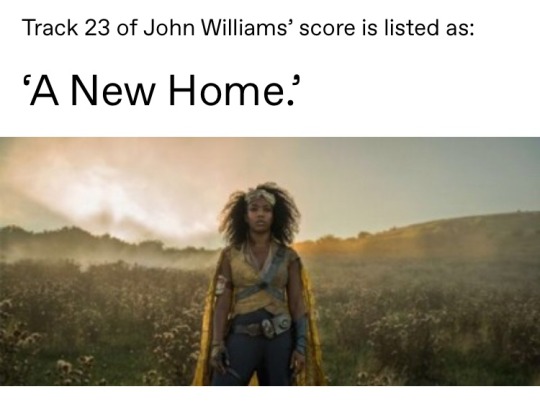
The fanboys say “leave the romance for the romance movies”....have you seen the original trilogy or the prequels? Star Wars has always had hope and romance entwined with it.
SO AFTER 40 YEARS...PALPATINE WINS...HIS BLOODLINE LIVES ON
...and people thought the prequels were bad
JJ you also said that your goal was for people to come out of the movie feeling more hopeful and happy then they went in...yet here I am. My roommate literally had to console me and buy me ice cream. I am just so numb. I am sure the casual fan will enjoy this, as seen from the rotten tomatoes ratings. I think the critics were too generous with this one,
Star Wars is very simple at its core, Good vs Bad and Dark vs Light. The kids are expected to understand that a Palpatine being the only one who lives is hopeful? That is the conclusion of three generations of Skywalker sacrifice...
This is how the Skywalkers are remembered...In Tragedy and Curse??
#the rise of skywalker#ben solo#reylo#ben solo deserved better#jj abrams#star wars#george lucas#a new home#adam driver#daisy ridley#rise of skywalker#luke skywalker#skywalker saga#kylo ren#kathleen kennedy#rian johnson#the last jedi#reylo fam#tros spoilers#tros
3K notes
·
View notes
Text
A Saga in Ruins: How the sets reflect the empty nostalgia of the Sequel Trilogy
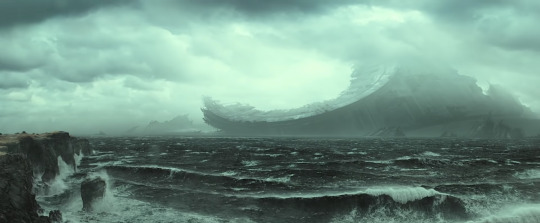
To the great surprise of many fans, the Skywalker Saga ended in the ruins of the Lars moisture farm on Tatooine. Perhaps this was intended to be circular, to be a coming home of sorts, but it was an odd choice for many reasons. Why would the youthful heroine find herself in an old, empty home to which she had no real connection, instead of on a verdant green world that she had so clearly craved earlier in her journey? Wouldn’t a place full of life be more fitting for a young woman starting a hopeful new chapter?
Of course, the dirty little secret is that there is nothing hopeful about the end of the Skywalker Saga. In fact, if we look across the Sequel Trilogy, we can see the theme of destruction, aging, death, and decay in many of the settings. Notably, the only sets that look truly new are the interiors of the First Order ships, and the rich luxury world of Canto Bight, but these sleek structures actually contain a moral rot.
It was appropriate for the Prequel Trilogy to be filled with shiny new sets as the Republic and Jedi were at the height of their power. The beauty was intentional, both so that we would appreciate the civilization that would be lost with the ascension of the Dark Side, and so that we would see it as the deceptive shell hiding the moral destruction within. In the Original Trilogy, the sets have an older, worn appearance, but are rarely what could be termed “ruins.” Given that the Sequel Trilogy takes place 30 years later when the galaxy has presumably been rebuilding since the Galactic Civil War, why then are SO many of the events set in ruins, or in places that become ruins?
Ruins in The Force Awakens
The first movie of this final trilogy started on Jakku, a ruin of a world home to the destroyed imperial fleet that made a last stand at the end of the Galactic Civil War. In the first scene of the film, new ruins are created when First Order troops destroy a village. Not long after, Poe and Finn crash-land into the desert, the ruin of their TIE fighter swallowed up by the sand. Later, we meet Rey, a lonely scavenger who is picking at the guts of a downed Imperial Star Destroyer. The shots in this sequence emphasize the scale of these ruins, along with the utter emptiness of the desert. Next, we see Rey in a little trading outpost cobbled together from disparate parts. She gazes dolefully at an elderly woman working the same task that she is, clearly seeing in the aged woman her own barren and lonely future. Finally, she travels to her own home, which turns out to be a collapsed AT-AT Imperial Walker. In an endearing but somewhat macabre moment, Rey dons the helmet of a Rebel X-Wing pilot. In a parallel scene, Kylo Ren is seen talking to the charred helmet of Darth Vader, beseeching his grandfather to speak to him. It’s nostalgia, yes, but for a past that is ruined, destroyed, and dead.

She next escapes Jakku in the Millenium Falcon, which might not be considered a ruin since it still (barely) flies, but it has clearly seen better days. Rey heaves the decrepit freighter through yet more bones of downed starships, finally escaping Jakku only for the Falcon to malfunction again. Han and Chewie, elderly yet vigorous as ever, join Rey and Finn and they all travel to Takodana, where Maz Kanata lives in a castle. From there, they witness the destruction of the Hosnian system, and then the First Order arrives and completely destroys Maz’s castle, creating yet another pile of rubble. The group next travels to D’Qar, a Resistance base nested in an old Rebel Alliance base from the Galactic Civil War three decades prior. Again, everything is old, aging, and recycled; nothing is new.
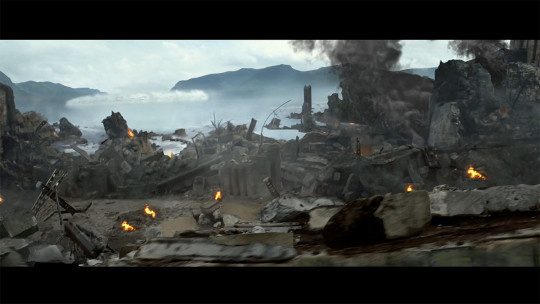
Starkiller Base is shiny and new, but it is also a tool of destruction, and before long it too collapses into space debris like Alderaan and Hosnian Prime. Meanwhile, we learn that the Skywalker-Solo family itself is in ruins, with Han and Leia split up, their son Ben fallen to the Dark Side, Luke missing in exile, and Han soon killed by his own son. Rey then travels to Ahch-To, where stand the ruins of the first Jedi Temple, to find the aging and bitter Luke Skywalker.
Ruins in The Last Jedi
On Ahch-To, Rey comes to find that the Jedi religion itself is in ruins, with their ancient texts abandoned and their one avatar, Luke, having cut himself off from the Force itself. In the course of her stay, she shoots a hole through the wall of her hut, slices through a large rock on the island, and emerges from the ruin of a hut that Luke explodes when he finds her with Ben Solo. Though Ahch-To is teeming with life, death is equally present, with Luke chatting with Force Ghost Yoda and watching the Jedi tree burn.
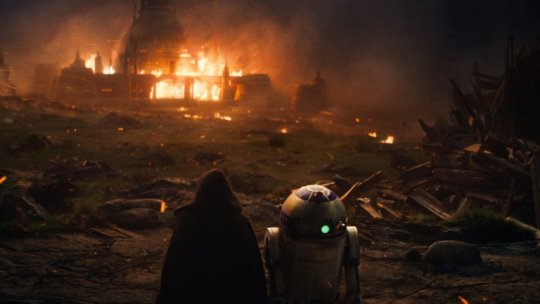
Further, Luke is a ruin of his former self, his moral certainty destroyed by regret. In the series of flashbacks to his last encounter with Ben, we see the hut collapsing, Luke rising from the rubble later, and his training temple in flames. Luke’s legacy, his relationship with his nephew, and now the physical manifestation of both is in ruins, as well. Even his X-Wing, once a symbol of his daring, sits submerged in water, presumably unusable and possibly scavenged already for parts.
On the Supremacy, the shattering of the Skywalker legacy is made visible in the breaking of Anakin’s lightsaber in the destroyed throne room. The ship itself lies in ruins after the battles that have raged across the ship and Admiral Holdo’s brave sacrifice, and even Ben and Rey’s fledgling relationship has been shattered by the end of the sequence.
Meanwhile, after the destruction of their fleet, the Resistance escapes to Crait, to yet another old Rebel Alliance base in the hope of escaping the First Order. Their speeders are so decrepit that Poe manages to punch a hole through one with just his foot, and the remaining forces are decimated before he makes the decision to pull back. With their massive laser cannon, the First Order punches a hole through the blast door to the base, effectively destroying it and rendering it unusable as a defensive position. By the end of the Crait sequence, the Resistance, their fleet, their base, and the central relationship of the movie between Rey and Ben are all in ruins.
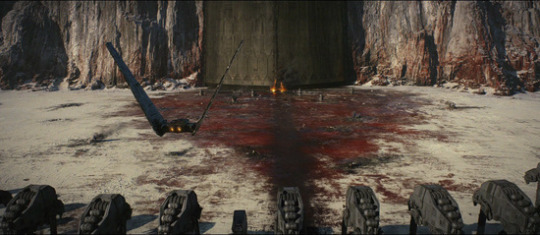
Though destruction and ruins abound in The Last Jedi, the framing is notably different from the other two films because the purpose of all this imagery is to show hope for the future springing from the rubble. Rey states this theme explicitly when she’s meditating for Luke on Ahch-To, saying she sees “death and decay that feeds new life.” The breaking of Kylo Ren’s mask and the legacy lightsaber are intended not as endings but as steps in the cycle of rebirth and renewal. Luke manages to shed his broken shell and become the young hero he once was, later achieving transcendence as he passes whole into the Force. Despite the massive wound dealt on Crait, the salt cleanses and covers the carnage, suggesting rebirth with womb-like imagery. Ruins in The Last Jedi tend to serve less as nostalgic settings and more as visual symbols of brokenness that must and will be healed.
Ruins in The Rise of Skywalker
As the final film of the sequel trilogy opens, we see Kylo Ren fighting a group of cultists, whom the TROS Visual Dictionary tells us are Vader loyalists. Leaked images from the art book and cut scenes suggest that this scene actually takes place in the shadow of Vader’s castle, also now a ruin in the absence of its dark master. Using the Sith wayfinder, Kylo flies to the Dark Side planet of Exogol, entering what appears to be an ancient temple of the ruined Sith culture. There he finds the resurrected but still deathlike Palpatine, who is clearly such a ruin of his former self that he must be kept alive by machinery and dark arts.

In returning to the forested, hidden Resistance base, Finn and Poe nearly destroy the Falcon yet again, with the old ship catching fire as she lands among a small collection of similarly ancient ships that appear to be in questionable flight condition. While running her Jedi training course, Rey uses the same pilot’s helmet and training remotes that Luke used over 30 years earlier to practice her skills, and cuts down a number of trees in the process, leaving a path of destruction in her wake. Not only does the continued use of old, OT-era objects confound logic, but the wanton destruction of the natural world seems at odds with the Jedi philosophy’s reverence of the life which creates the Force.
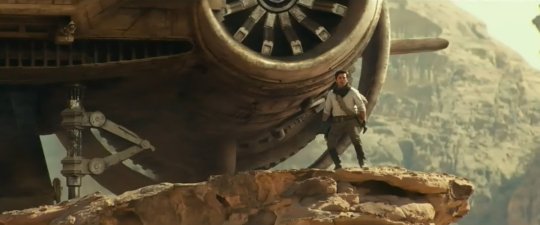
Rey’s vision leads her to the barren desert world of Pasaana, where she meets the now-elderly Lando Calrissian, then finds the wreck of the ship that pursued her family when they were fleeing the resurrected Emperor. In the ruin of Ochi’s ship, Rey finds D-0, a broken and abandoned droid who yet again mirrors all the broken and abandoned characters (literally, ALL of them) in the Sequel Trilogy. When Kylo Ren appears, Rey first destroys his TIE Whisper, then when he crawls from the wreckage, the two have a Force tug-of-war over a transport ship which ends in Rey destroying it, as well. Of course, it later turns out that Chewbacca was not aboard that transport, thus continuing the pattern in this film of laying waste to the new planets, ships, and characters that were created for the sequels, while those from the original trilogy are miraculously preserved.
The gang next travels to Kijimi, where they apparently need to destroy C3-P0′s memories in order to unlock his ability to translate an ancient Sith language. As with Chewie, this is merely a temporary “death,” and Threepio’s memories are restored later. Kijimi, unfortunately, is not so lucky, and it is rather unceremoniously blown up, like Alderaan and Hosnian Prime. It seems that even with their allies, the Resistance heroes leave nothing but destruction in their wake.
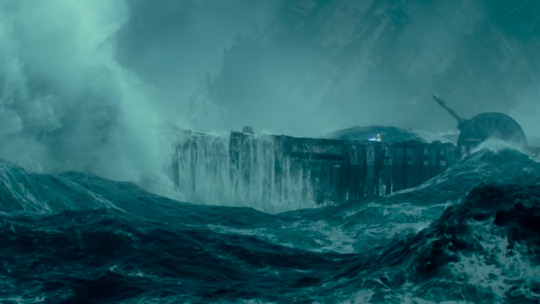
Rey and friends next land on another moon of Endor, and the poor Falcon takes another beating. While her friends work yet again to repair the old ship, Rey escapes alone to the most imposing ruins of the entire film, collapsed shell of the second Death Star from Return of the Jedi. Calling back to not only Luke’s ordeal there, but also Rey’s own origins scavenging in the carcasses of Imperial Starships, the partially-submerged battle station serves as the backdrop for still more violence and destruction. When Ben Solo arrives, Rey engages him in another duel, which ends with Leia dead and Ben mortally wounded. Though Rey heals Ben, she next flees to Ahch-To, abandoning him and taking his TIE Whisper with her.
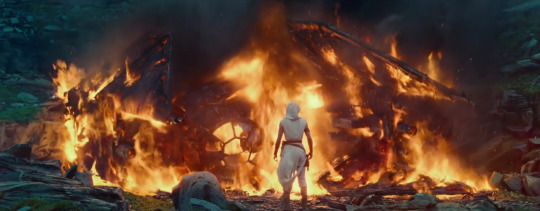
On Ahch-To, Rey burns the TIE, standing before the flaming ruins and attempting to throw her lightsaber into the fire. Luke stops her, then leads her to an abandoned hut to find Leia’s lightsaber, a remnant of her aborted Jedi training. Lastly, Luke raises his X-Wing from the water, offering it to Rey inexplicably space-worthy and no worse for the wear having been underwater for the better part of a decade and being at least 35 years old.
Finally, all the characters converge on Exogol, where they continue to engage in as much destruction as possible, including the apparent annihilation of an entire Sith civilization who lived on the planet as part of Palpatine’s Final Order. Ben Solo also arrives on the planet to help Rey (in another OT-era fighter that is miraculously space-worthy and moreover made it across the galaxy WITHOUT A HYPERDRIVE), but Palpatine sucks the power from him and then throws him painfully down a chasm, leaving his body broken. The climactic sequence ends with thousands dead, ships destroyed, and even Rey dead (or something) on the ground. Ben drags his broken body up and across the wreckage of the arena, and dies after resurrecting her, thus ending the Skywalker line.

After a celebratory hug with her friends, Rey flies the Falcon to Tatooine, to the literal ruins of the Lars Homestead. This is the place we last saw belching smoke as Owen and Beru’s charred remains splayed grotesquely across the scene of Luke’s destroyed childhood. Recalling again Rey’s beginning scraping a meager and lonely existence from battle wreckage, she slides down a sand dune on a loose piece of debris, and precociously explores the place. Finally, she buries Luke and Leia’s lightsabers (further cementing this place as a graveyard since Shmi is also buried here along with the Lars), and declares herself to be a Skywalker, the heir to these ruins.
Nostalgia as Love of a Dead or Imaginary Past
So, what does it all mean? If the Sequel Trilogy relies on ruins as a setting more than the other two trilogies, why does that matter? Isn’t it just paying homage to all the stories that led to the saga’s conclusion? Doesn’t it simply tie everything together?
Most critics and fans agree that the Sequel Trilogy relies heavily on nostalgia. In particular, JJ Abrams is often criticized for using nostalgia to such a degree that many of his films are direct copies of the stories they’re referencing: Super 8 is a mash-up of films like E.T. and Stand By Me, Star Trek: Into Darkness is a copy of The Wrath of Khan, The Force Awakens is nearly identical to Episode IV: A New Hope, and so on. Nostalgia is defined as:
“A sentimental longing or wistful affection for the past, typically for a period or place with happy personal associations.”
Most of Abrams’ movies succeed in creating this feeling because they rely on a shared cultural childhood memory. We fondly remember iconic moments from the films we loved as children, so seeing those moments again creates a feeling of remembered happiness. These movies encourage the viewer to recall how they felt the first time they saw certain images by repeating those images.

The first problem with this approach is that nostalgia is for the audience, not for the characters. The believability of the characters’ actions suffers when they are forced to act out scenes from a story that is not their own, from lives and perspectives that are not theirs. The audience might love seeing a lightsaber battle because that’s quintessential Star Wars, but if the two (or more) characters have no logical reason to fight other than as a spectacle for the audience, then the scene will lack any emotional depth. Likewise, a character revering someone whom they either barely knew or openly loathed makes no sense. In the case of settings or props, characters must respond to them in a way that is believable based on their actual history (or lack thereof) with the place or object. If the main characters of a story function only as a sort of modern Greek chorus, mirroring the nostalgic reactions of the omniscient audience, then they fail to be characters at all and become the most reductive versions of a self-insert.
This video explains the problem well, from 7:09 to 10:58 (the whole video is good but fair warning that not all of his takes align with what I believe about Star Wars, especially as regards Kylo Ren/Ben Solo):
youtube
Another problem with this reliance on nostalgia is that in order to speak to a shared childhood experience, everyone in the audience must have had similar childhoods, or at least belong to the same generation so that they all fondly remember the same things. This is necessarily exclusive, as different generations have vastly different collective experiences and memories. The members of the audience who were children at the time of the Original Trilogy’s release or shortly after grew up in a very different world than those who were children during the release of the Prequel Trilogy, or from the generation living through childhood now. Some things that older generations remember fondly carry uncomfortable or even traumatic associations for younger generations, so something intended to be nostalgic will not impact all audiences in the same way.
The legacy saber is a great example of this: an older Original Trilogy fan might be delighted to see Luke’s inaugural lightsaber from the very first Star Wars film being passed on to the new generation, but a younger fan who grew up with the Prequels might see it as a tainted symbol of Anakin’s fall to the dark side and a weapon stained with the blood of innocent younglings. A family sword meant to press the nostalgia button in The Force Awakens instead invokes a feeling of dread and horror in fans with different associations. While Rian Johnson mentions deliberately referencing the Prequels in his creation of The Last Jedi, JJ Abrams and Chris Terrio make no secret of the fact that they don’t acknowledge those films, and it shows.

Lastly, Star Wars has always been a story of youth, of coming of age, growing up, and becoming one’s own person. Luke’s story in the Original Trilogy was about him learning who he was independently of his father and mentors. He is merely a boy, young and defiant, and through his own mistakes he learns how the elder generation was wrong, resolves to do better, and thereby redeems them. Anakin’s story was similar, except that he was unable in his youth to learn the right lessons from the failures of his mentors, his defiance taking a more destructive form. In contrast to both of them, Rey learns.... that all her mentors and parental figures were right all along. In the end, she defies no one, discovers no new and better way, and ultimately brings nothing new and different to the galaxy. She brings no peace or renewal, adopting a legacy of death and destruction to cap a life that has featured only the old, dead, and destroyed.
This is where Disney and Abrams tip their hand and the true philosophy underpinning the Sequel Trilogy is revealed: in an effort to appeal to the nostalgia of older Star Wars fans, they fail to tell a story of youth and instead offer an orgy of death-worship and aesthetic decay. Rather than having the Star Wars conclude with Star Peace, the final trilogy seems to say “Weren’t those wars great? Don’t you miss them? Don’t you want to be reminded of all those wars?”
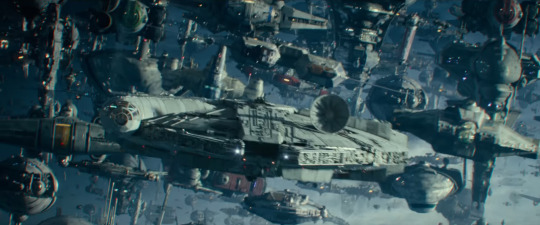
In her book The Future of Nostalgia, Svetlana Boym defines the term a little differently than the dictionary:
"Nostalgia (from nostos - return home, and algia - longing) is a longing for a home that no longer exists or has never existed. Nostalgia is a sentiment of loss and displacement, but is also a romance with one's fantasy."
Boym points out that memory is often faulty, and that fond recollection is often a reaction to current despair. If things are bad now, it is natural for us to imagine a more comforting past, as with popular references to “the good old days.” In fact, another translation of the root algos is “pain,” thereby associating the return home with pain. Is it pain that prompts our longing to return home? Pain that creates the fond memory of home in the first place? Perhaps home itself is a source of pain, and so our minds construct an imaginary home that is better than the reality. In any case, it is typical that our rose-colored glasses distort the truth of what we long for, so the danger of nostalgia is a disassociation from truth.
One of those truths that we might deny in our fantasies is the ephemeral nature of human life and experience. All things age, decay, and ultimately cease to be. They may be evergreen in memory, but in a contiguous timeline like the Skywalker Saga, every location, object, or person must inevitably show the passage of time. Thus it is that the youthful heroes of the Original Trilogy become wizened and less vital when they reappear in the Sequels, that old ships break, and symbols of better times shatter and burn. As Boym states, however, the nostalgic lives in denial:
“The nostalgic desires to obliterate history and turn it into a private or collective mythology, to revisit time like space, refusing to surrender to the irreversibility of time that plagues the human condition.”

Nostalgia cannot hide the steady march of time, which is why most stories look to the future and the creation of the new. Not so the Sequel Trilogy. At no point in the story does there appear to be a goal outside of “defeating the latest bad guys, who are identical to the old bad guys.” There’s no vision of the future toward which the characters are striving, neither on a galactic level (achieving peace) nor a personal level (starting a new family on a vibrant living planet). As such, with nothing to look forward to, the story can only look backward, trapped in nostalgia for a past that appears worse the closer you look at it.
This is why the Sequels are filled with characters, objects, and places from the Original Trilogy that are revered in spite of their violent and even traumatic pasts, not to mention visible signs of age. Ultimately a story that has nothing new to say or offer, only weak attempts to recreate a half-remembered childhood feeling of an aging generation, can ONLY logically end in a graveyard. Viewed in this light, it makes sense that the young protagonist builds her life around fond memories that for her are only imaginary, surrounded by the visible evidence of death and decay to which nostalgia blinds her.
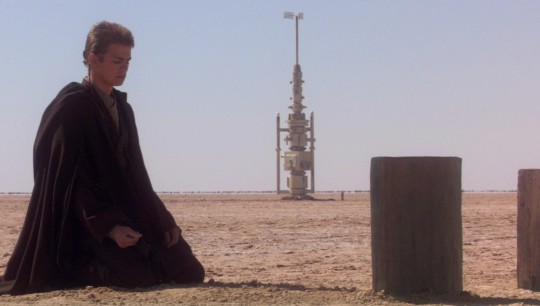
If this is all the fan in the audience is looking for, a faded echo of their favorite memory, then perhaps that is enough. But for those who do not share the reassuring memory, or those who look forward to the future and how things might change for the better, the ending of the Skywalker Saga offers only knowledge that all things fade and die. Without the lens of nostalgia, the Sequel Trilogy is merely an empty tale of death.
#star wars meta#sequel trilogy#star wars sequel trilogy#sequel trilogy meta#tros meta#tros#the force awakens#the last jedi#the rise of skywalker#skywalker saga#star wars#rey#rey of jakku#jakku#tatooine#death star#ruins#a saga in ruins#luke skywalker#princess leia#general leia organa#han solo#shmi skywalker#lars homestead#nostalgia#jj abrams#star wars criticism#millenium falcon#legacy lightsaber#anakin skywalker
401 notes
·
View notes
Text
Star Wars: The Clone Wars “The Phantom Apprentice” -Review
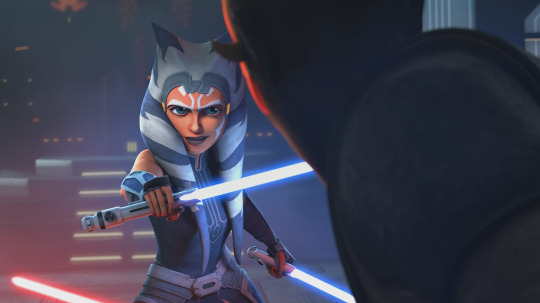
The Clone Wars creates a horror movie of inescapable dread in the game changing, “The Phantom Apprentice”
(Review contains episode spoilers)
youtube
Maul and Ahsoka Tano are now face to face. As the battle for the future of Mandalore unfolds around them, it becomes clear that something much larger is at stake. The fate of the galaxy hangs in the balance and everything that is known will change. And our heroes and villains are powerless to stop it.
It’s been known for quite a while that the end of The Clone Wars would tie into the events of Revenge of the Sith. The show has been on a collision course with this darkest installment in the Star Wars saga ever since it premiered in 2008 and now the inevitable moment has arrived. Everything in the galaxy is about to upend itself and the feeling of dread and tragedy hangs over everything. While The Clone Wars has dipped its feet into the horror genre before, director Nathaniel Villanueva and writer Dave Filoni have created a half hour experience of impending dread and terror.
The Clone Wars was always going to end in heartbreak. Revenge of the Sith was the inescapable end point for this series, but the unspoken cruelty of this series is in the unaware insignificance of its own cast. Ahsoka Tano, Rex, Maul, the Mandalorians are doomed to be side notes in the galaxy altering Skywalker Saga. Their narratives are twisting, emotional, and undeniably engaging but they will never escape living in the margins of the adventures of the mythic figures they count as their friends, allies, and enemies. There is a knowing futility to Filoni’s script for “The Phantom Apprentice” that pervades everything. We can be watching titanic battles unfold on the streets of Sundari and daring lightsaber duels, but it’s all for nothing. Composer Kevin Kiner, still the only musical talent that has come close to mirroring and expanding off the legendary work of John Williams, turns the aural landscape of this conflict into a sound that can only be described as Star Wars meets Hereditary. We are never once made to feel comfortable. There are no hints that this will work out. It won’t.
Like the standout season finale to Star Wars Rebels’ second season, the title of “The Phantom Apprentice” is deceptively nuanced. It’s actually in conversation with three different characters, one of whom never actually appears on screen.
The most obvious of the three is of course Maul, the original apprentice to The Phantom Menace. I’ve never hidden my adoration for the long, strange character arc that Lucasfilm Animation has taken this formerly one note villain on. Sam Witwer, Dave Filoni, and the rest of the creative team have transformed this former Sith assassin into a perpetually broken and emotional frail man that is never more than a few steps away from collapse. First hinted at in one of his first appearances on this series, Maul was always aware to some degree of The Clone Wars and the larger machinations of his master. The pieces were always in place and now Maul is slowly realizing that the end goal of his master’s decades long plan is finally upon them. And it terrifies him. Long gone is the confident Maul who thought he could carve out an Empire for himself in the shadows of the galactic underworld. After Darth Sidious’s humiliating beatdown of him in “The Lawless” and the murder of his mother in the Son of Dathomir comic series, it’s now clear to this lost Zabrak that his master is the most powerful being in the galaxy and something to be feared above all else. Witwer plays Maul’s former anger and jealousy at having his dreams of grandeur robbed of him as a transformation into existential collapse. He realizes that he really is nothing more than a cast aside bit player in the revolution that is about to come and he is determined to stop it from happening. Not out of any kind of good will or redemption, but out of his own desperation for survival and relevance.
I’ve always been a tad skeptical of one of the final confrontations of the series being a duel between Asoka Tano and Maul. Not at all because Ahsoka isn’t capable of taking on a character like this wayward former Sith. She’s more than proven herself able and “The Phantom Apprentice” more than sells that Maul is definitely not acting at full capacity. (We’ll talk more about that fantastic confrontation later along with the rest of the stellar action here.) Instead, I was concerned that this clash would feel hollow. Ahsoka and Maul do not have an existing relationship prior to “The Phantom Apprentice.” Their big climactic meeting of sabers could have been nothing more than a set piece that was created only because they were the only characters free during the Revenge of the Sith era to have one. That is very thankfully not the case.
Filoni smartly positions Maul and Ahsoka as two sides of the same coin. As Maul was eventually cast out and discarded as useless by Darth Sidious, Ahsoka was also tossed away by the Jedi order by their own dedication to doctrine and lack of trust. Both are victims of their respective order’s worst qualities and exist as relative outcasts. However, the true dramatic irony of it all is that by doing so, both Ahsoka and Maul are arguably in better positions to survive the coming slaughter and possibly put an end to it. Sure, Maul’s argument for their teaming up to stop Sidious is mostly self-serving (even if I suspect that it does have some root in the sad sack of a Sith’s perpetual need for companionship and belonging), but Ahsoka considers it for a moment because she can see the truth in it all. It’s a fascinating moment and the fact that it feels emotionally genuine is a true feat of Ahsley Eckstein, Witwer, and the entire creative team. We can’t not acknowledge that incredible shot of the shattered glass and embers blowing through the wind as Maul’s fateful offer is made.
The final apprentice is of course Anakin Skywalker. Perhaps the most startling development of “The Phantom Apprentice” is Maul’s revelation that he is more than aware of Anakin’s eventual slip to the Dark Side and it was probably in the cards for quite some time. (His moment of post-mortem pity for Dooku is a fun wink to how doomed all of Sidious’s apprentices were on their eventual march toward Anakin’s ascension.) It recontexualizes so much of the final days of The Clone Wars and of Sidious’s plan itself. Of course as Anakin’s fateful seduction to the Dark Side is occurring parallel to the events of the Siege of Mandalore it is more than fitting that Maul is not the only one with Anakin on his mind. The brief call between Obi-Wan and Ahsoka comes from a place of compassion, but it ultimately serves as further example of Ahsoka’s suspicion of the Jedi. She sees a kindred spirit in Anakin at the moment that the Council betrays his trust and how could she not. The fact that Ahsoka and Maul’s duel happens mostly as a retaliation to the assertion that Anakin will fall speaks to her unbreakable trust in her surrogate older brother. It ends up playing as a bit of a fight for Anakin’s soul. Hope versus despair and denial versus inevitability.
And what a battle it is. Dave Filoni mentioned at Star Wars Celebration last year that they brought in original Darth Maul stunt actor Ray Park to assist with the animation for this fight and it certainly shows. While it may not be the most sprawling duel ever or as brutal as Pre Vizsla and Maul’s duel to the death, The Clone Wars has never featured a confrontation as fluid and dynamic as this one. The constant back and forth of the upper hand and the emotional instability of both fighters gives this encounter a strange edge that ratchets up the tension even if we know both combatants are destined to make it out of this alive. The final stage in the scaffolding that holds up the city of Sundari is a standout and brings to mind a similarly stellar set piece from Mission Impossible: Rogue Nation.
It’s not just our phantom apprentices that get in on the action this week. A claustrophobic showdown between Bo-Katan and Gar Saxon in an elevator shaft is one of the most inventive set pieces that the series has produced and Villanueva sells it with a cluttered intensity that never loses clarity. A prolonged battle between the liberating forces and Maul’s loyalists is similarly brutal and striking with sweeping tracking shots of the action that smartly know when to cut into the carnage and when to transfer back to other scenes. It brings to mind some of the great multi-tiered battles in Star Wars history and it once again gives big screen live action installments of the franchise a serious run for their money.
A few random final thoughts!
It seems only fitting that Almec would be gunned down by one of his own allies. Gar Saxon is poised to take over Almec’s position as the self-serving Mandalorian leader in the era of the Empire and there’s certainly some poetry in this sort of cyclical killing. Poor Mandalore. Planet’s not going to sort itself out anytime soon.
Jesse lived! I’m sure every one of us clone junkies were prepared for one of our last surviving 501st boys to fall to Maul this week, but through some small glimmer of positivity the newly minted ARC Trooper survived. I’m not sure we can be as hopeful in coming episodes, but I’ll take the positivity where I can find it.
I actually really loved Maul’s cameo in Solo: A Star Wars Story and it’s nice to see “The Phantom Apprentice” tee that up with the blink and you’ll miss appearance by Dryden Vos. Was really hoping for a tiny line of dialogue from Paul Bettany, but I guess that’s as good as we’ll get for right now.
Sam Witwer remarked several months ago that the scripts for the final arc of The Clone Wars were the best the series ever produced and it’s hard to argue with that. Never before has this saga had more on its mind or felt as emotional or consequential. It’s a nail biting stunner of a chapter and I’m genuinely in awe that we are only half way done. Buckle in folks. This is when the pain really begins.
Score: A+
#Star Wars#The Clone Wars#Clone Wars#Star Wars: The Clone Wars#review#reviews#The Siege of Mandalore#Ahsoka Tano#Maul#Dave Filoni
54 notes
·
View notes
Note
*sigh* why do people keep comparing r/eylo to zutara and putting them in the same group? Were they not paying attention to the show? Did they not see Zuko's evolution?
Honestly, I really don’t know.
Like, ok, superficially, I can almost kinda get it. Angry boy with a scar on his face and the girl who could kick his ass offering to heal him? Ok, fine. Even aesthetically, red and blue, tol and smol, fine. I can sorta see it. But the instant you dig even a little bit deeper, they just… aren’t the same at all???? Not even remotely????
And, ok, I’ll admit to some measure of bias, because I don’t ship reylo and I don’t like it as a ship, nor do I want it to happen in any way in canon, but like, part of the reason Zutara works so well is that it’s not a hero/villain ship. It’s enemies-to-lovers, for sure, but the vast majority of us ship it because of Zuko’s redemption arc.
Yeah, you’ll see ‘I’ll save you from the pirates’ UST jokes, and a lot of us started shipping it back in book 1, but it was obvious from the beginning that Zuko was going to get redeemed. He may have been a villain, but he was never the villain–he was narratively placed as the secondary protagonist (deuteragonist) of the show from his very first appearance. He was given his own narrative arc that had little to do with the main plotline of Aang’s journey, because while his own journey ran parallel to the gaang, it was separate and distinct because he was on his way to his own redemption even then.
Zuko Alone, in book 2, drove this home even further. You don’t give someone who isn’t the primary protagonist of the show an episode all to themselves (literally none of the gaang shows up for even a second) unless this is a character who’s meant to have just as much narrative significance as the main cast. Zuko was always going to join the gaang, and so much zutara meta and fanfic rests on how amazing and emotionally fulfilling their relationship development was, as friends, and that it would have made so much sense for their friendship to go even further.
Reylo doesn’t have any of that.
First of all, Kylo Ren is not Zuko–not even close. Kylo has far more agency in being dark than Zuko ever did. Ben Solo had loving parents and grew up in a supportive environment. His uncle ultimately made a mistake, sure, but a) we see three versions of that particular story: the sanitized version (luke), the demonized version (kylo), and the truth, and b) kylo already had the knights of ren all ready to go and slaughter a bunch of kids.
He was already dark. You don’t go and murderdeathkill a bunch of kids and people you’d ostensibly been raised with just because you saw your uncle standing over you with a lightsaber he clearly wasn’t going to actually use unless you were already making plans to do just that. You can blame as much of it as you want on Snoke and his influence, but that would be a little like blaming Palpatine for Anakin–yeah, he gets some of the blame for manipulating the situation, but Anakin’s still the one who made the choice to kill a temple full of children and choke out his own wife. Darth Vader may have, in the end, chosen to return to the light, but that doesn’t absolve him of the evils he chose to commit.
Kylo is, tragically, in the same narrative position as Darth Vader was in the original trilogy–and Vader couldn’t even bring himself to kill his son. But Kylo chose to kill his father. And that, incidentally, is one of the places where Zuko and Kylo are essentially diametrically opposed. Zuko turned on Uncle Iroh, yes, but he didn’t cross a line from which there was no coming back–he didn’t kill him. He, in fact, kept going to see him, trying to figure out why the choice he’d made felt so wrong when it was supposed to be everything he’d always wanted. Meanwhile, Kylo murdered his own father because he was hoping to destroy that last link to his own humanity.
And he succeeded.
Furthermore, Rey is not Katara. I love them both, so much, but they are very different people, and different characters who fulfill different narrative spaces in their own stories. In Rey’s position, Katara would probably have killed Kylo in the throne room when he turned on her after killing Snoke. Or, placing Kylo in Zuko’s place in atla, if he’d killed Hakoda (remembering that Han was the only father figure rey’d ever known)? She would have destroyed him. No fucking mercy
Katara does not forgive easily. It took Zuko not only proving that he was on the side of good (which he did multiple times, one of which he even saved her father), but specifically proving to her that he cared for her and genuinely wanted to help–by helping her gain closure for her mother’s murder. She emotionally connected with Zuko in the crystal catacombs, sure, but when he turned on her she hated him and had no intention of turning back. (Even though, from Zuko’s perspective, it wasn’t a betrayal at all–he’d made no promises, and it was his sister offering him everything he’d ever wanted. As far as he was concerned, the only person he betrayed there was his uncle, which is why it took him so long to realize just why Katara hated him so much. And even then he needed her brother’s help to figure out how to fix it.)
On the other hand, Rey was ready, willing, even eager to believe that Kylo could be returned to the light side–could become Ben again. This after he’d done something utterly unforgiving right in front of her, and tried to kill her multiple times. (Notably, at no point during Zuko and Katara’s antagonistic relationship was Zuko actually trying to kill her. He was trying to capture Aang. The worst thing he did was burn down Suki’s village, and that was largely an accident, because he was trying to get to Aang to capture him–alive.) She wanted to believe there was good in him. Katara couldn’t have cared less, throughout the first two books–and then, when confronted with the fact that Zuko had suffered something to which she could relate, she connected with him… and he turned on her. (From her perspective, she’d just reached out and offered this boy a chance to prove he’d changed… and he threw it in her face. So yeah, she took it incredibly fucking personally.)
Even now, it’s possible that if Kylo comes at Rey with some ‘I’m really light now’ story, she’ll probably want to believe him. But even if Reylo happens (and I’ll stress that I really don’t think it’s going to, and if it does I’ll probably be bitterly disappointed, but what else is new) it won’t even remotely resemble Zutara because they are, at their core, incredibly different relationships. Katara didn’t start warming up to Zuko, after that book 2 betrayal, until after he’d proven himself again and again, and helped her begin to heal from the trauma she’d suffered as a child. Furthermore, Zuko was never that evil to begin with. He was being primed for a redemption arc from the start, and he never even came close to the sort of moral event horizon Kylo pole-vaulted over when he murdered a whole bunch of students in their beds and then killed his own father.
And here’s the thing a lot of these Zuko-lite redemption arcs don’t seem to understand–it’s not a one-size-fits-all storyline. You can’t just slap Zuko’s redemption arc on any old villain, because for a redemption to work, it needs to be tailored specifically to fit the villain in question. And most villains aren’t Zuko–he was a very special kind of ‘secondary protagonist who starts out bad and gets a little bit worse before he gets better and joins the good guys’, which most villains can’t hope to match. If you want to redeem someone who’s canonically done far more atrocious acts, their redemption has to encompass the fact that not only are they getting better, but they are actively atoning for the horrible things they’ve done.
Killian Jones, from Once Upon a Time, had a redemption arc which looked nothing like Zuko’s, because he wasn’t a villain like Zuko. His redemption involved not only coming to realize that he’d been doing bad things for a very long time in search of a vengeance which was, ultimately, not what he really wanted or needed, but also making amends to the people he’d hurt over his very long life (those he still could help, at least). (Interestingly enough, that same show had a great example of a horribly botched redemption, in which we were supposed to take it on faith that the character was Good Now even though she’d never once expressed either remorse for the evil she’d committed [which was a lot more evil than Killian ever had] or a desire to make amends to those she’d wronged. In fact, come the end of the show, she still had a vault full of stolen hearts she’d never so much as made an effort to return, even though many of their owners were, ostensibly, in the same town she’d created through one of her many acts of villainy. It was… kind of strange, to say the least, to see how they could get one villain’s redemption so right and another’s so horribly wrong.)
Anyway, tl;dr: the upshot of this all is, Kylo Ren is not Zuko–he’s not even close–and Rey is not Katara. Their relationships look nothing alike, and even if Kylo is redeemed, it’s not going to look anything like Zuko’s redemption–partly because Zuko was never that bad to begin with and Kylo would have much more for which to atone, partly because their narrative journeys are so very very different–and I have never understood the comparison beyond a very surface-level reading of their character aesthetics.
175 notes
·
View notes
Text
Rey’s New Last Name Within the Context of her Relationship With Leia
Okay so I never in my wildest dreams imagined that we would get enough of a substantial Leia-Rey relationship in TROS (given the limited footage they had of Carrie) for me to be able to write meta about it, but here we are.
I have a lot of Thoughts™ on how Rey was deliberately paralleled with Leia in TROS, and frankly on the Rey-Leia relationship in general and how they are compared/contrasted to each other (and also some sad thoughts about how this relationship might have been even further explored in an Episode IX where Carrie didn’t die). I’ll be expanding more on how each of the Trio embody different aspects of Leia in TROS later, but that’s a different discussion for another time.
So TROS makes a big deal about comparing Rey to Leia. She’s been taught by Leia for the past year, Leia’s story is the one that gets brought up in relation to Rey’s fight against Palpatine/Kylo, Luke gives her Leia’s lightsaber and tells her to ‘finish Leia’s journey’, and the movie makes a special effort to note that both Luke AND Leia are watching over Rey on Tatooine when she goes to honor her mentors, bury their lightsabers, and move forward into her new life. Poe gets to be Leia’s more direct successor as Leader of the Resistance, asking Leia for help and guidance even after she is gone, but it is Rey who is handed Leia’s spiritual journey…her journey as a Skywalker and a Jedi rather than as an Organa-Solo, Princess, and General.
And what we see with Rey’s journey in TROS is that it’s very similar to Luke’s journey in Return of the Jedi as he wrestles with trying to save someone from the Dark Side while confronting the Emperor, but it’s also scarily similar to the emotional journey Leia undergoes in Legends canon while she is trying to accept the fact that Darth Vader was her father in Truce at Bakura and Tatooine Ghost (which culminates in her naming her youngest son Anakin in that verse as a sign of understanding and realization that she can move on and honor the man Anakin was without forgiving what he did to her or the galaxy as Vader). I haven't read enough of post-ROTJ new canon material to gauge whether she has that same struggle in the current canon, but I suspect she has.
Rey has a lot to come to terms with in a very short amount of time. She’s struggling with her fear of herself; what she’s capable of and what she can do to others, even on accident. Leia struggled a lot with that fear too, both in Legends and new canon, and that’s why it’s important that Leia gets to tell Rey to “never be afraid of who you are.” Because she’s been there. She’s been there, wondering if her future is tainted and her fate is set in stone because of her parentage. She’s been there, wondering if she would hurt someone on accident because of her anger and her inablity to control herself….wondering if she would hurt her son and doom him to his fate by becoming a full Jedi Knight. And it makes it all the more touching that Rey was chosen to take up Leia’s spiritual journey and not Luke’s, especially in light of the fact that Ben was clearly intended from the start to be paralleled and contrasted with Luke.
And Rey being told by Luke to address that fear head-on, to pick up Leia’s saber and finish the journey Leia started, has enormous implications for her relationship with Ben/Kylo, because Leia has been trying to reach him for years. She sent Han after him, she tried to communicate with him through the Force on multiple occasions, she never lost hope (even when she says she did), and she died still trying to reach him and bring him back to her. And yet we have Rey, explicitly appointed to be Leia’s spiritual successor, who finally faces her fears about her own self, reaches Ben, and gets him to understand that it’s his fear that's holding him back. It's not too late (and it’s never too late) to change and become a better person than you are.
TROS finally gave the depth to the Rey-Skywalker family conflict that needed to happen at the beginning of TLJ, because it finally gives us a reason why Rey wants to stay and fight this fight. Why she cares in any way, shape, or form what happens to Kylo Ren if she’s not related or intimately connected to the Skywalker-Solos in some way. Why she believes he can still come back.
Rey and Leia are on two different sides of this conflict with Ben/Kylo; Leia has been desperately trying to find and reach her son for years and Rey is unwittingly pulled into this conflict by force, and yet in the end Rey stays. She stays for Han, the man she was starting to regard as her father figure. She stays for Luke, the man so embittered and scarred that he tried to turn her away but ultimately taught her as many lessons as she taught him in the short time they were together. And most importantly, she stays for Leia, the woman who finished her training, who took her in and trusted her and helped her and loved her, who believed that she was already worthy of Luke’s saber even if she didn’t believe it herself. And finally, finally, in the Death Star wreckage, she realizes that she is staying for Ben, because she can still see the man he has the potential to be, the man that Han, Luke, and Leia all died trying to save.
She may carry Han’s blaster at her side, and Luke may have been the one to give Rey her first lessons, and it may be Anakin’s lightsaber that Rey uses throughout the majority of the trilogy, but it is Leia’s journey that Rey is set to finish. It is Leia’s lightsaber that Rey takes with her to Exagol with the intention of using. It is Leia’s spiritual journey to become a full Jedi that Rey completes by facing her fears. And it is Leia’s struggle to reach her Fallen son that Rey finally succeeds at accomplishing. Poe is Leia’s most enduring legacy as an Organa and as a leader, but Rey is ultimately Leia’s most enduring legacy as a Skywalker and a Jedi.
And that is why Rey taking the name Skywalker fits. By doing so, she honors the man who started her spiritual journey and the woman who helped her finish it, the family that helped her see that she was trusted and loved regardless of where she came from, what she had done in her past, and who her parents/grandparents were. They give her explicit permission (via their smiling faces as Force Ghosts) to carry their name into the future as she carries their legacy, and Rey does so with a smile on her face, hope in her heart, a new lightsaber of her own at her side, her friends waiting for her at her new home, and eyes fixed firmly on the future.
#tros spoilers#sw spoilers#leia organa#rey skywalker#star wars#long post#the rise of skywalker#this is all jumbled together and I'm SUPER sorry but I just wanted to get it out#anyway adopted!ReySky is CANON and MAKES SENSE and I will FIGHT YOU on it
54 notes
·
View notes
Text
Thoughts on TROS
So just saw The Rise of Skywalker.
And I literally just said “Wow.” when I walked out of the theater, though I did not know it was a good wow or a bad wow.
It’s a very mixed bag for me with this one, I can see why the critics hated it, I can see why some fans did not like it, I can also see why people may like it. I loved TFA and I actually did not think TLJ was that bad of a movie at all. But given that, I do believe that the intended story had lost it’s way in the middle, culminating into TROS, which Abrams tried to salvage whatever intended end they meant it to be.
Spoilers ahead so turn away.
Don’t get me wrong, while I did enjoy the movie, there definitely was some things they could have handled better. The movie was meant for closure, but instead left a gaping hole.
The greatest disservice I felt they did to Finn and Rose. Finn’s storyline in the beginning of the trilogy had massive potential, but instead he was more or less reduced to being the new Chewie of the trilogy, just a side piece with no more on his story and him finding himself more. Plus, they literally “Seinfeld” his ending. So wtf was he going to say to Rey? I was thinking it would probably be a FinnRey ship at the end of TFA, until TLJ literally blew that to pieces (which turned my Reylo, more on that later). The Stormtrooper who turned should have been a more interesting story, instead was thrown aside. Plus the intro of the other turned Troopers, that really does set up for Disney+ further down the road does it? Rose they just set aside as well, which is quite the opposite of “support” given the backlash against her character. She is a stronger character in this, but not entirely necessary. Shame.
A positive is that I did like the little delve into Poe’s past. It actually is in parallel with Mando’s storyline in The Mandalorian, except his former mates are not sleazeballs. Plus, I am quite interested in the history he had with Zorri. She was a fun character.
I’m kind of glad to see 3PO being of some use finally instead of being a whiney cunt of a droid. And his little stab at R2′s memory not being reliable, I was thinking, umm...he kept the Princess’ recording for that many years, and I bet he probably backed your useless tinhead up as well you dummy. Which he did. Poetic justice really for just a douchebag of a character. I never did understood why it was such a popular character. Even when I recently rewatched the original trilogy, I find myself thinking this is why R2 curses so much.
Then we come to Rey and Ben. Did Sheev actually set this whole thing up so that he can use the Skywalker heir and his heir’s Dyad connection to revive hisself? Snoke was just a puppet?! All this time was just to buy time for building a fleet. And do NOT tell me he used The Yodaling in some form to keep hiimself alive. God damn that was convoluted plan! All the while that little scavenger girl was just a rook in her own family’s great game. It was like every step she took was calculated by her own blood, but is it though?
I think the whole theme Abrams wanted in this trilogy is choice, and how your background does not define your destiny because you have choice. Finn was a Stormtrooper, but he had a choice and turned (obviously writers did that and left him). Poe was a runner, but he made the choice to fight in the Resistance. He had a chance for safety offered to him and he did not take it either. If you think about it the OT and the PT had similar tones with Anakin/Vader and Luke (and now we found out Leia) had a hand in their own destinies through choice. Ben chose Dark before because he thought it was in his blood, believed it was his destiny and especially when his uncle reacted the way he did. Turned out it was not. Rey was to be damned to join the Dark side because of her background, but in the end made that choice. Even if Palpatine was the puppet master all this time. I just think the whole theme does tie into OT, but it really could have been more refined in the execution.
I really do hate it when people call Rey a “Mary Sue” character. Luke in the OT was the same way. In fact she had even more conflict in her than younger Luke did as a character, so there is a little more depth to her.
I definitely think that Ben/Kylo had the best scenes and the best story arc of the trilogy. While the movies focused on his relationship with Han more, I felt that he himself had a bigger connection with Leia through his actions. Each time he felt his Mom through the Force, he reeled back. Her death and his little “BARF( Binarily Augmented Retro-Framing-a-la-TonyStark)” moment with Han made him turn. It made me curious as to the relationship young Ben had with his mother. He definitely loved his mother, I really wished they could have explored that even more. Sadly due to circumstances that we know, it was not. Leia’s fear that the end of her Jedi days would mean the demise of her son. I think when Luke said that to Rey, I knew what Ben’s ending would be. I believe had she overcame that fear and remained a Jedi, she might have been the one to train him. That would have become another story.
Gosh I really wish that they didn’t go for that ending though. Which they actually had to for full redemption, but it really did leave a gaping hole in my little Reylo heart. I wish they would really go full Disney cliche for once and let them be!!! Though....I know I will get crap for it, but the kiss was a little bit too much. But that smile though, that hug, and that little cradle of each other’s cheeks...if just leaving it at that, the moment would surpass “I know.” as the greatest love confession in the history of that galaxy IMO. Rey and Ben gave each other their lives, and themselves back to each other. Rey found out who she was and who she turns out to be, Kylo became Ben again. But it didn’t really feel like closure to me. But realistically though, even if he had survived, they would not be. Ben sure has hell would have to have to pay for his crimes though he does redeem himself. Sadly, reality does not allow for all the Reylo babies even if we wanted.
But that smile though....

can we just leave it at this?
Come to think of it, were they still Force-Skyping each other while Rey was being trained by Leia? It seems like it given how they felt for one another. Rey saying “Be with me. Be with me.” I don’t think I was the only one that thought she was calling out to Ben unconsciously, which is why she got distracted.
(and what Rey did at the very end, you bet The Mouse can use that to set up for later movies)
#tros spoilers#rey#Ben Solo#Kylo Ren#The Rise of Skywalker#It really should have been Rey Organa-Solo but the title won't sell#Reylo is canon#spoilers#Star Wars
8 notes
·
View notes
Text
Did Rian save the Knights of Ren by changing one detail of the Force vision?
The Knights of Ren are one of the remaining mysteries of this new trilogy, one many look forward to discover in IX and love to speculate about.I remembered Rian addressing their absence in VIII during an interview he had given to the Empire Film Podcast but had never really given much thoughts about it until I tried to find a transcript of the conversation (unfortunately there is no full re-transcription of the 2 hours long podcast but a few articles picked up the relevant parts).Here is what Rian had to say about the Knights of Ren:

Rey’s force vision in The Force Awakens gave birth to a ton of speculation and the presence of the Knights of Ren around Kylo Ren made it one of the most dissected 30 seconds of cinema in recent years.
That’s why, reading those lines out loud, I squeezed my eyes and tried to picture the Throne Room with the Knights of Ren in lieu of the Praetorian guards, then the Force Vision with the Praetorian Guards in lieu of the Knights. Then the throne room again, then the Force vision...
That’s when the remark of Rian took a very specific meaning.
In Force Awakens J.J.Abrams gave Rey her first Force vision - upon discovering the legacy saber stashed away in Maz’s basement, our heroine glimpses what has been in the past and what is still to come - A premonition so upsetting Rey runs away, refusing the call to adventure, only to be forced into the arms of destiny (quite literally).
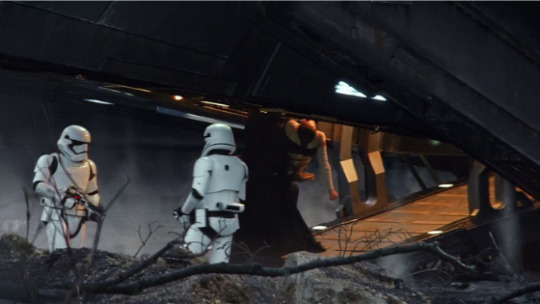
As a fandom we pretty much agreed from the start that the words spoken to Rey by Maz in the corridor were a clever bit of foreshadowing regarding Ben Solo’s redemption.
On the other hand there’s still much to discuss about the sequence in the rain because the presence of the Knights around Kylo Ren renders the timeline ambiguous. Is it the past? Is it the future? Did Kylo sense Rey and that’s why he was moving towards her? Who is the Clan leader?
Today I want to postulate that in TFA the sequence in the rain is actually Rey’s premonition of what is going to happen in the Throne Room.
To illustrate this theory, allow me first to draw parallels between how the two sequences play:
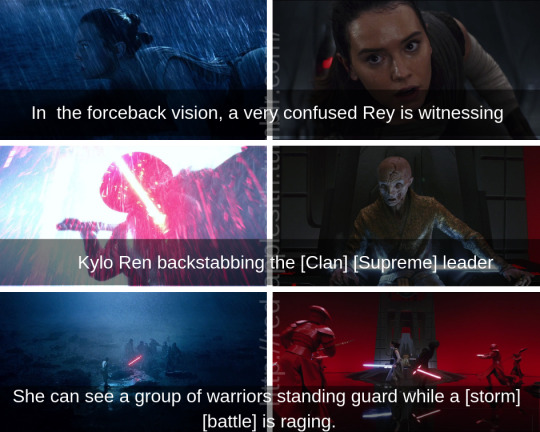
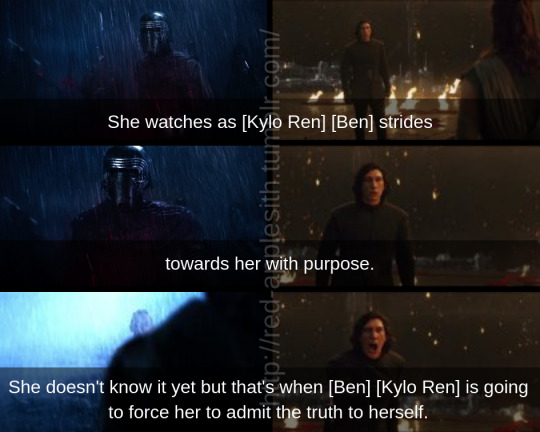
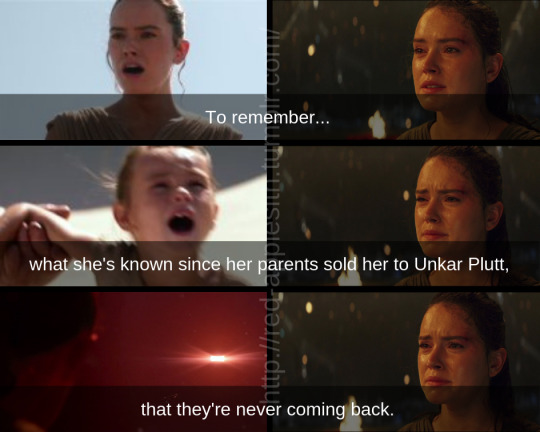
It works, right?
‘But!’ you’re going to say ‘there are many elements that are different between the two scenes, including most importantly the presence of the KOR’ which is why I’d like to delve into more details under the cut.
1. Visions in the Star Wars universe
“The dark side clouds everything. Impossible to see the future is.”
– Yoda
If there’s one thing the Jedi and Anakin taught us is that Force visions are not documentaries. They are made of symbols that are meant to speak or inspire a truth to the beholder (not even ‘the’ truth)
In the case of Rey, her latent Force powers just awakened and she’s never experienced anything like this before so it’s no wonder her first reaction is to panic and flee. Keep in mind that she has no idea what she’s seeing and how to interpret it - except for the part about her childhood of course.
That part she knows all too well, but as it’s been established she’s not ready to accept the truth at the start of her journey, which is why in insight, perhaps Rey doesn’t flee because she’s scared of meeting and fighting the monster from the vision but because she’s trying to flee the truth inside herself.
And the truth is precisely what Rian needed Rey to confront to allow her character to grow in TLJ. That’s why I believe that Rian kept the vision as the blueprint for the Throne Room because it was a good scene but also decided that not all elements of the vision needed to be incorporated. The KoR are a minor detail in the scene after all. Rey’s turmoil is what really matters.
2. Codename "Clan Leader"
Before I delve more into the symbolism and metaphors of the Force vision, I’m going to discuss the codename “Clan leader”.
Because we focused a lot on the Knights in that scene before TLJ came out (and even after), it never occurred to me before I started to connect the dots that clan LEADER may have been the most obvious, in your face piece of information given about the identity of the guy killed by Kylo in that scene.
After all there are plenty of clans in the Star Wars universe - Mandalorian, Padawan, witches, etc...
In that respect, Clan leader could refer to almost anything, really.
Except that, as a fandom we were keen to observe that said Clan Leader was about to strike Rey, and that by killing him Kylo Ren was actually saving her.
Does that ring a bell? Because that’s literally the plot of the Throne Room - The Supreme Leader brags that he plans to kill Rey “with the cruelest stroke” only to be betrayed - and cut in half- by Kylo.
Nuf’ said.
3. Metaphors and emotions
As mentioned previously, visions are not very good at giving out details of what is going to happen exactly. At best, they are filtered by the individual receiving them, at worst they’re bent to fit one’s personal fears and end up becoming self fulfilling prophecies of doom.
That’s where I think it’s interesting to postulate that if Rian did use the Force Vision as blueprint for the Throne Room, he chose to be pretty straightforward about it, which is why the only true difference is the absence of the Knights of Ren.
So, let’s examine further two key elements of the Force vision to see how ‘similar’ the seemingly differences actually are.
The backstabbing
Like established a few lines above, in TLJ Kylo betrays Snoke to save Rey. So is it a coincidence that we see him backstabbing the clan leader in the vision? You can argue a lot about Kylo, that he’s unhinged and unpredictable at times, but there’s something that TFA and TLJ established very well, it’s that he has a certain moral code. Although he’s scared shitless to see Luke appear on the battlefield, he still gets out of the comfort of his shuttle to face him one-on-one. When he fights Finn, he acts like a peacock but he only uses his lightsaber, never once trying dirty Force tricks.
So how are the chances that he would strike an opponent in the back? Probably nil to be honest.
But what else the act of backstabbing evokes automatically? Betrayal.
That’s the reason why I believe that the Vision is the visual representation of Kylo’s betrayal of Snoke.
The storm
The final element I want to draw attention to is the storm. Bodies are piled up on the ground, the rain is lashing down, tying the vision of Luke and artoo to the vision of Kylo Ren and the KoR. Rain in Star Wars always seems to bring a sense of heightened dramatic tension and that’s why Rey fights Luke under an identical stormy night sky.
Of course, it doesn’t rain aboard star ships. Although we have this lovely, almost intimate “fiery rain” all around Rey and Kylo.
But coming back to the vision, my proposition is that the storm is a visualization of the battle raging inside and outside the Supremacy. The Resistance fleet is being decimated by the First Order. There’s a sense of danger and urgency as Rey is standing in the middle of it all.
Conclusion
This meta is already getting longer than I wished so I’m going to wrap it up here. All I really wanted to say is that, whether Rian did or didn’t use Rey’s Force vision as the blueprint for his Throne Room, I’m glad he decided to spare the Knights and I hope we’ll finally see them in IX.
603 notes
·
View notes
Photo
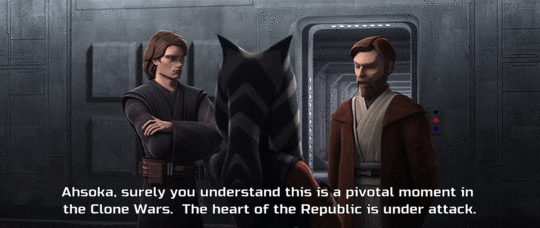
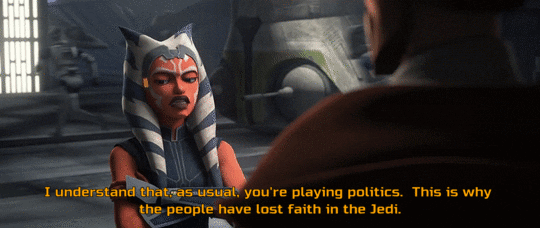

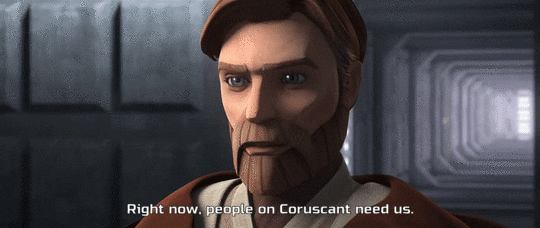
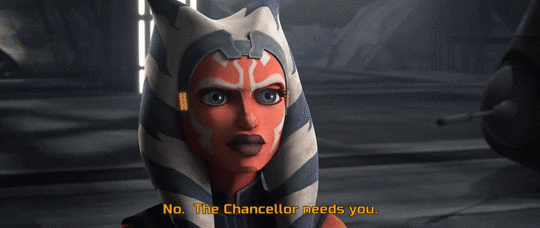
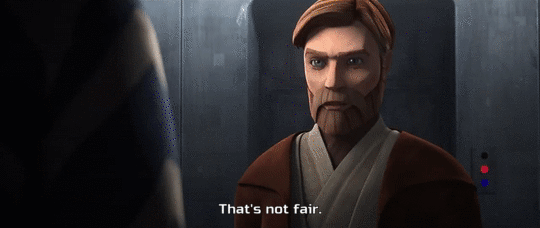
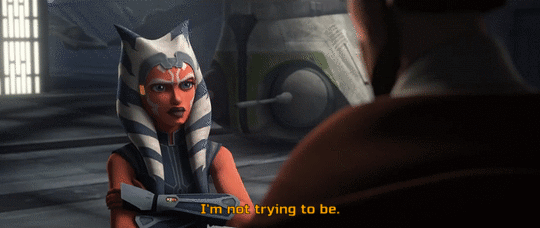
IF YOU STRIP CONTEXT OF THE REST OF THE SHOW--HELL, EVEN OF THE REST OF THIS EPISODE--FROM THIS SCENE, I can see how we should be siding entirely with Ahsoka, especially on the heels of the walkabout arc and her conflict with being drawn back towards the Jedi and the Jedi Order. Her points aren’t wrong, in the sense that she’s right that Obi-Wan is playing politics with this, but she’s stripping context and consequence out from the choice he faces and that’s specifically why he says, “That’s not fair.” and even Ahsoka herself says, “I’m not trying to be.” Her accusation is not fair. Because, let’s say that Obi-Wan did exactly what Ahsoka said--that he prioritized the people of Mandalore over saving the Chancellor. We’re setting aside that this was a manipulation on Palpatine’s part and that Mandalore is a trap, only what we can see from Obi-Wan’s point of view and his motivations, his good faith assumptions on why rescuing the Chancellor is important. If they chose Mandalore over Coruscant, what would happen is: - They would be drawn into yet another war because they had broken a treaty, when they’re already stretched to the breaking point for this first war. - The Chancellor may be the one in trouble, but what does Ahsoka think will happen if the Chancellor dies or is ransomed back? The Republic would be in chaos, the war effort is already balanced precariously, and none of them know that the Separatists aren’t the real threat. Whatever good reasons many of the Separatists may have, they murder, enslave, and oppress the worlds they attack. If the Republic loses the war, that’s what happens to every world in the Republic. - The Jedi might be more popular with people if they saved Mandalore, but would it really benefit the galaxy as a whole, given a good faith assumption on what these characters would know? (There is no right answer to this question, of course.) Ahsoka is very nearly arguing for popularity over doing the more important thing, because this isn’t a situation where there aren’t consequences. Mandalore needs their help, but so too does Coruscant and it’s not just about the Chancellor, it’s about the Republic as a whole. And it even comes down to--why are politics bad? I get that Ahsoka means that choosing your actions based on politics is a calculated sort of thing, but why is that bad? Because Star Wars: Propaganda basically posited that that was the problem, that the Jedi didn’t play enough politics, that’s why their image was so bad. Ahsoka’s case for Mandalore could be argued to be the same thing--you want to win back the public’s faith, then you have to take this path. That right there is politics, too. EVERYTHING IN THIS WAR IS POLITICS. NOTHING CAN ESCAPE IT. BECAUSE POLITICS IS EVERYTHING LIKE WE ARE LIVING IN A WORLD THAT HAS DEMONSTRATED THAT TO US VERY CLEARLY. AND WE SHOULD ALL LEAN INTO POLITICS, RATHER THAN SEPARATING OURSELVES FROM THEM. If politics were inherently bad, we wouldn’t see characters like Padme Amidala, Bail Organa, and Mon Mothma--or, hell, even Leia Organa herself--as heroes. Because politics are important! You don’t have to be (and shouldn’t be) a full-time politician for politics to still be important. That working within a system to help better it and be able to reach more people is a good thing. Further, this doesn’t come without context of earlier in the episode, Obi-Wan is specifically shown to be incredibly desiring of helping people--he basically caves to Anakin’s strategy based on Anakin’s argument that they can help people sooner:
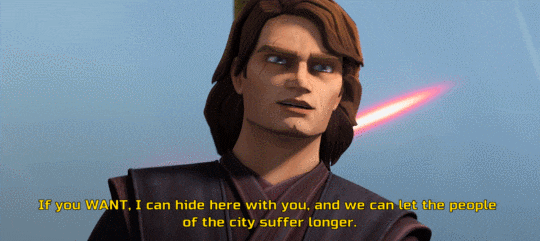

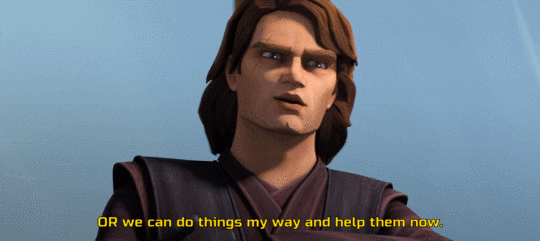
That is right there in this very same episode. Obi-Wan agrees to a reckless strategy specifically when Anakin points out that it can help people sooner. Obi-Wan Kenobi is not someone who doesn’t want to help people, that’s his whole thing! Further context, which isn’t specifically related to this particular issue, but does give context to Obi-Wan Kenobi as a character is everything with Bo-Katan seething over whether Satine even meant anything to him. She did. And she still does. But he cannot allow his feelings to cloud his judgement--and that is something that is key to being a Jedi.
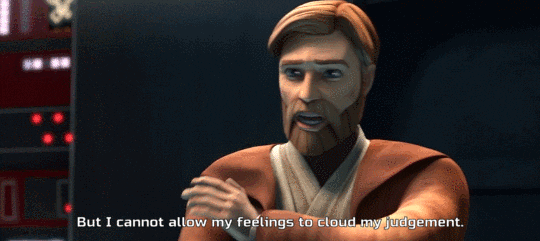
It reminds me of George Lucas’ commentary on attachment: “But [Anakin] has become attached to his mother and he will become attached to Padme and these things are, for a Jedi, who needs to have a clear mind and not be influenced by threats to their attachments, a dangerous situation. And it feeds into fear of losing things, which feeds into greed, wanting to keep things, wanting to keep his possessions and things that he should be letting go of. His fear of losing her turns to anger at losing her, which ultimately turns to revenge in wiping out the village.“ –George Lucas, Attack of the Clones commentary “He turns into Darth Vader because he gets attached to things. He can’t let go of his mother; he can’t let go of his girlfriend. He can’t let go of things.” –George Lucas, Time Magazine interview (2002) The thing about Obi-Wan/Satine is that it was pretty clearly created to be a foil to Anakin/Padme (and, boyyyyyyyyy, is that abundantly clear in the scene with Bo-Katan where Anakin is STARING at Obi-Wan as he says this, as we all know Revenge of the Sith is looming riiiiiiiiight over our heads), where Obi-Wan and Satine do make the right choices about the vows they’ve taken to other aspects of their lives. That they are balanced in a way that Anakin and Padme are not. Dave Filoni says it himself in the commentary for the Bad Batch arc, in this very season: “I mean, even Obi-Wan was in love with someone. That’s not abnormal. It’s very normal. What you choose to do and how you choose to have a relationship, what you sacrifice, then that becomes a bigger deal when he’s made an oath to the Jedi Order to be selfless, to put everyone else ahead of himself.” --Dave Filoni Obi-Wan’s feelings for Satine are very much a parallel and contrast for Anakin’s feelings for Padme, and we know exactly how that’s going to turn out for Anakin, because Revenge of the Sith looms incredibly large over this entire episode and this entire arc. ”He’s made an oath to put everyone else ahead of himself.” is something Obi-Wan has done and continues to uphold, so accusing him of politics is like--what does Obi-Wan gain by playing politics then? He’s putting other people ahead of himself, so playing politics must be for that reason, too. Furthering this context, especially in tying it to what it means to be a Jedi, is commentary from “The Lawless”:
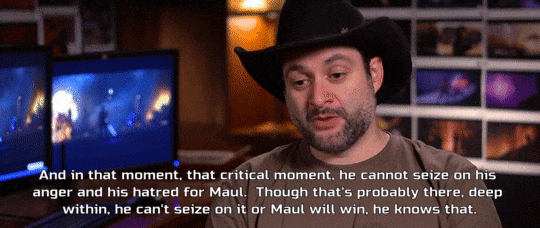
”And in that moment, that critical moment, he cannot seize on his anger and his hatred for Maul. Though that’s probably there, deep within, he can’t seize on it or Maul will win, he knows that. I think we learned a lot about Obi-Wan and what it means to be a true Jedi, which is what I see Obi-Wan as.“ –Dave Filoni, on “The Lawless” All of this is important to understand that, when Obi-Wan Kenobi talks about the choices one makes, about not letting his feelings cloud his judgement, he’s coming from a place of established narrative reliability. We want to side with Ahsoka, because her hurt is so genuine and valid. Because she sees a problem with the way the galaxy views the Jedi and we know that the Jedi’s doom is soon upon them. (And this is where I get wary of the show’s narrative potentially trying to say, “Well, they’re kind of responsible for their own genocide because they just weren’t nice enough to people and only helped so many people, that they should have done more and more and more.” because, no, fuck that idea for real, the Jedi are not responsible for their own genocide, certainly not based on anything in the canon!) She wants to fix this problem and she’s coming at it with a choice that she thinks would restore faith in them. The problem is that the Jedi are being asked to make choices between what’s popular and what they see as doing more good for more people. And there’s a great line from the Age of Republic - Padme Amidala comic that ties into these themes as well:
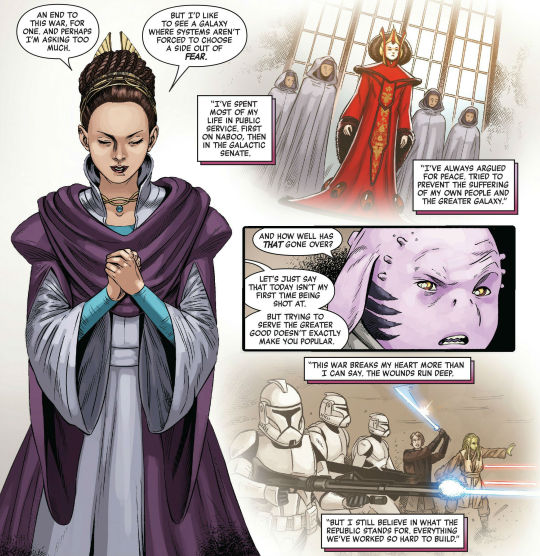
“But trying to serve the greater good doesn’t exactly make you popular.” (Oh, hey, look! More politics!) On first blush, the idea of helping the people of Mandalore over saving the Chancellor seems like the right thing to do because we know Palpatine is Sidious, we know that it leads to ROTS, we know that ROTS leads to the Empire, especially when Ahsoka ties it to the Jedi Order becoming unpopular with the galaxy. But Obi-Wan points out that she’s not being fair. He points out that the Republic is on the line. I’m pointing out that everything is politics, one decision over the other isn’t less political just because it’s more intimate. And it doesn’t come without context. It’s not just the Chancellor, it’s bigger than that. And serving that greater good--as Obi-Wan genuinely sees it--doesn’t always make them popular. And still even further, this isn’t entirely about the Jedi Order’s politics, but it’s about Ahsoka’s own hurt at how the Jedi had to play politics with her, too. She’s still hurt that they expelled her--though, as always, context shows that she gave them absolutely nothing to work with, she immediately distrusted them before they even heard anything, she refused to even send them a message, she attacked clones on her way out, she was seen colluding with a known Separatist war criminal, she was found with incredibly damning evidence, and still wouldn’t actually talk to them or ask them directly to trust her, and ultimately none of her own actions saved her, it was a Jedi who saved her--that this doesn’t negate that they made mistakes as well, they should have visited her in the jail, they were playing politics and it doesn’t matter to Ahsoka that their hands were forced--and that’s driving her conversation with Obi-Wan, especially as someone who is part of the Council that she feels betrayed her. And Obi-Wan’s coming at this from the point of view that she let her emotions cloud her judgement over what happened, that she reacted blindly rather than trusting them in the critical moment (and the theme of trust was allll over that arc), and she’s still coming from this from a place of emotion, but that he respects her choices in the end and he obviously still cares very much about her.
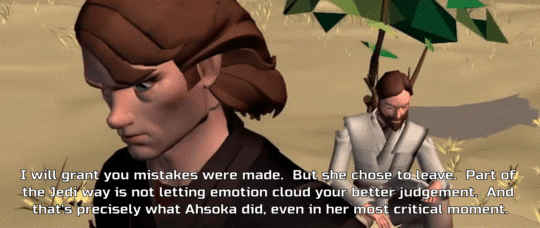
All of that is underlining the conversation and one of the things that makes it such a hellishly complicated scene here in “Old Friends Not Forgotten” is that both of them are pretty narratively reliable. They’re both coming from a place of deep care and a desire to help people. They’re both coming from a place wanting to do what’s best for people. Which is why I love that I think Ahsoka genuinely loves the Jedi Order and why she says, “people who truly need us”. It furthers my feeling of how I think, had Order 66 not happened, she may have come back to the Jedi eventually, if this difference could be resolved, but at the very least she certainly never hated them. This is all coming from a place of love for the Jedi, for her family. Even if she’s on a different path, even if ultimately she’ll say, “I’m no Jedi.” in Rebels, that’s about what she’s willing to do, what lines she's willing to cross, that a Jedi wouldn’t, and that it doesn’t mean they’re not still her family and that she wants good things for and with them. And why I love that she may not be being fair here, she may be stripping context and consequence out of the choice she wants to make, she may be letting emotion cloud her judgement, but she’s still so incredibly valuable and I do think they should have listened to her more. The Jedi’s genocide is not on them, the murder of an entire people can never be on the victims, but I do think Obi-Wan has so much weight on his shoulders that he has trouble seeing the forest for the trees. And that’s not a horrible thing, especially because Ahsoka’s shoving the trees aside here. But that there was no right answer here. Mandalore is a trap. Mandalore is going to fall to the Empire anyway. Coruscant is a trap. Coruscant is going to fall to the Empire anyway. It doesn’t matter if they choose Mandalore or Coruscant. Order 66 is already set to be triggered any minute now, nothing can stop that. Them being more popular wouldn’t have saved them from it, not in a galaxy where the Republic general public was apathetic enough to not stand up against the Separatist themselves, instead allowed a clone army to be commissioned and the Jedi to be drafted into the war. They wouldn’t stand up for themselves against the Separatists, they weren’t going to stand up for the genocide of a tiny religious culture, either. It doesn’t even matter if the Jedi fought in the war or not--fight and be killed. Don’t fight and they’ll be like Mandalore and be forced into it anyway or killed. That the Jedi were forced to make shitty choices in situations where there weren’t any right answers and get blamed for not having magical answers to problems that they cannot possible solve. What really brought that home to me was the way the scene ended--when Anakin offered an actual reasonable, viable solution (something that most people don’t offer the Jedi when saying what they should or shouldn’t do, they’re rarely given actual, workable options) where they could do both, Obi-Wan pretty readily jumped on it.
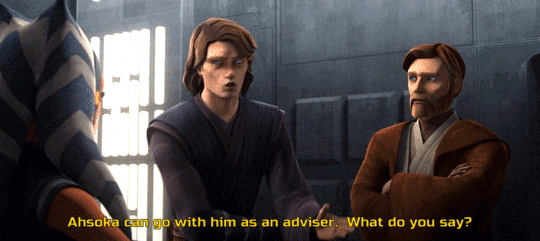
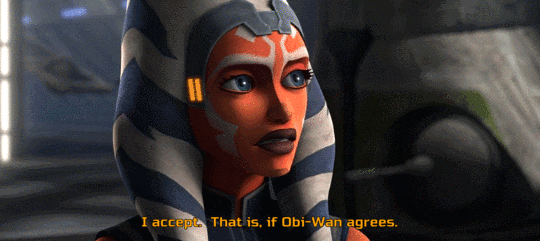
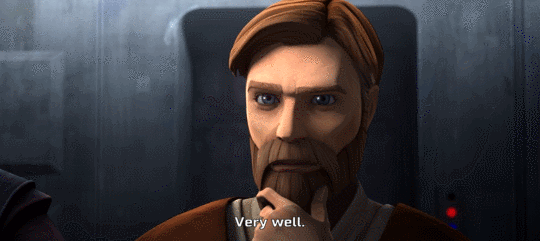
This shows that of course the Jedi want to help, whenever and wherever they can. Not going to Mandalore isn’t that they don’t care or that they don’t want to help, but that there are two tire fires put in front of them and they didn’t see a reasonable way to do both, and Coruscant, as the capital of the Republic, which is the only body that can possibly stand between the Separatists and the enslavement/oppression/murder of thousands of worlds, must be protected. (Just look what happens when the Republic and the Jedi fall--the Empire inflicted atrocity after atrocity on the galaxy, which says to me that the Jedi were right in that the Republic had to be defended because it was all that stood between the galaxy and a lot of really evil things happening.) Ultimately, the only thing that the Jedi could really do that mattered is that they helped save people--people like Hera Syndulla--and they did do that. And the accusation that they’re not trying to help people is not a fair one. Even when it comes from a place of deep care. And that’s why this scene was ouchy in such a good way, it really was an amazing episode to watch!
2K notes
·
View notes
Text
I’ve just read the new “The Rise of Kylo Ren” interview with Charles Soule (the writer) and Will Sliney (the artist) and thought I’d do a post about it because there’s some very interesting stuff
And also I may or may not be absolutely amused at some descriptions for the former leader of the Knights of Ren
[More under the “read more” because of spoilers of TROKR, and because of speculation/theorizing of TROS.]
“They call him Ren, but that wasn’t always his name.
“Born out of the flames,” as artist Will Sliney puts it, the leader of the Knights of Ren in the opening pages of the new comic Star Wars: The Rise of Kylo Ren #1, arrives battle-scarred and wearing a fearsome, featureless mask — a blank expression save for a smattering of claw-like gouges. Concealed within is a charismatic leader, the exact type of person who would be able to seduce young Ben Solo away from the path of the Jedi.”
They’re going to talk about “The Rise of Kylo Ren”—they spent the first paragraphs mostly talking about Ren
And... *arching eyebrows at the first phrases* So... “They call him Ren, but that wasn’t always his name”, and “born out of the blames”, and “fearsome, featureless mask”... Yeah, this totally does nothing to stop me from thinking Ren’s gonna be future/alternative Ben
Alexa, play “Dark Horse” *looking sideways at Dark Rey and Ren*
“I wanted him to read like a charming Darth Vader,” says writer Charles Soule. “A Vader who is charismatic and who is appealing. That’s why [Ren’s] skin is burned and he sort of looks the way that he does. He’s embracing the seductiveness and the damage that the dark side does. Darth Vader, as impressive and imposing and terrifying as he is, is remote and cold and distant because he has the suit surrounding him. Whereas Ren isn’t hiding behind it. He’s someone you could have a beer with, in theory.”
Oh, so are we going parallel territory with the Darth Vader, like previously with Ben and Anakin? Interesting... *munches popcorn* Also lol at having a beer with him
“Designed purposefully for the new comic series, with issue #1 out now, Ren feeds the evolution of Kylo Ren. “The entire seductiveness of the dark side poured into one character engineered for Ben Solo is Ren,” Soule says. “He’s sort of a charming evil rascal that can be really fun to write and I really like where he goes in the series. But if Kylo Ren is going to take over the Knights of Ren, which we know that’s what happens, there should be some transition.”
I didn’t think I’d see Mr. Hottie McHotHot aka Ren defined like a “sort of a charming evil rascal”, but yeah, that’s kriffing funny and awesome and I can’t wait to see what happens in January
But now... now comes the super juicy bits...
“The creative team engineered some surprises for this charming dark sider, a foil in many ways to Darth Vader hiding beneath his protective covering. “You expect the dude hiding his face under a mask like that to be all messed up, particularly with his body looking the way it does,” Soule says. But in issue #2 we’ll see what he’s truly concealing, a reveal that speaks to Ben on a whole other level.”
Why does this sound familiar? ... Ah, yes, because it’s kind of the way they described Ben‘s unmasking in TFA, the whole “you expect a monster but you got this young tortured prince”. Sounds like that a lot. Also, the fact that what he’s hiding under the mask seems it will be a huge reveal to Ben and that they’ve “engineered some surprises for this charming dark sider”? Not to mention that, again, we have a comparison with Darth Vader
Yep, this definitely does nothing to keep me from going on with my Ren/Ben theory
“I think the key to writing Ben Solo is to write him as a lost teenager who is deeply in touch with emotions that teenagers often feel,” Soule says. “He feels like no one understands him, no one sees him the way he actually is, he’s utterly alone and there’s no one else out there in the universe. So when he sees Ren, he’s like, ‘Wait a minute — maybe there is somebody like me in the universe. Maybe there is a path for a guy like me. Look at the choices he’s made. I could make those choices, too, and I could be cool.’”
Okay, so, who the kriff is cutting onions in the room? *Ben feels intensify*
Also there might or might not be a certain Disney song going on my head right now reading this lol
“The story also calls for the re-introduction of a younger, seemingly kinder Snoke, wearing a little cap, no less. When we meet him in the series, the future Supreme Leader of the First Order is essentially a gardener. “When we were in the design process, Snoke is someone that you know is going to defy expectations and it’s not going to be the Snoke that you know,” Sliney says. “And it’s important because we’re going to see a very, very different relationship that Snoke and Ben have. It establishes that this is not the Snoke that’s going to Force-choke Hux and slam him into the ground. He’s playing the long game…so it was important to portray Snoke differently.
And true to his festering nature, Snoke inhabits a place that on the surface seems serene and beautiful, but is rotten at its core, a script note that spurred Sliney to google “rotting fruit” for artistic inspiration.”
Snoke is a scary predator. Whatever he is, whatever it’s his relationship with Palpatine, that’s the thing—they’re both scary predators, and I can’t even begin to imagine all the shit fed to poor Ben’s head
Also, about that world... Another thought that came to me (besides Mortis stuff) is that maybe it could be the deserted/stormy place we see in the TROS trailers, like the planet finally rotten inside and outside, kind of as a reflection as to how appearences have fallen apart and all that’s left to show is the rotting
“Like Sheev Palpatine, the once humble senator of Naboo, “Snoke is someone who knows the playbook,” Soule says. “It’s a similar play in terms of, ‘I’m a nice guy who’s just trying to help you,’ which is kind of what Palpatine did. But Snoke’s path to power, Snoke’s seduction technique, Snoke’s message and teachings are, I think, pretty different from the way Palpatine did it…. His job is not so much to corrupt as it’s to represent an alternative to the legacy [Ben has] been presented.” In concert with Ren presenting an alternate path, Snoke’s suggestive philosophy is appealing to a young boy who feels lost. “Everyone’s telling you you’re X, but what if you’re Y? What feels correct to you? Are you Obi-Wan Kenobi or maybe you’re something else?” Soule says. “All you need to be is whoever you are and no one’s letting you do that…and maybe, shouldn’t you go someplace where you can be who you are?”
Now that’s a specially terrifying way of predating—you may be able to get away from all the people you love, detach from them so as to protect them and protect your heart, but you can’t run away from yourself and your thoughts and feelings, and that’s what Snoke targets with Ben
“To bring these characters alive on the page, Sliney pulled reference material from Celtic myths and poured over books featuring the art of Star Wars. “I don’t think I’ve ever studied as much as I have,” he says. “Everything Star Wars. I have all those art books, whether it’s the modern ones or the ones from the original movies or the prequels. I love the art…I think it’s important to pay respects to the amazing concept art that have made these movies along the way.”
Those artists, of course, famously took their inspiration from earlier works, so Sliney went back even further. “I’m going backwards as much as I can in terms of the feel of it,” he says. “It needed to feel epic and it needed to feel powerful. It’s bringing it back to that mythological kind of feeling. I have a big influence from a lot of old ancient Celtic stories that date back thousands and thousands of years. These stories of lone warriors who died on the hill…. Those ancient books, they carry that gravitas.”
That’s interesting. Maybe the big “dead” tree around the machinery comes from Celtic mythology? After taking a look at some info, I’d say this screams “tree of life” to me, which would pretty much fit like a glove with the Force and the balance because it represents harmony and all that. Also, if you want to know something funny, according to this webpage (Irish Around the World), “trees were a connection to the world of the spirits and the ancestors, living entities, and doorways into other worlds”, it says, among other things
And, to finish:
“Meanwhile, Soule pulled much of his writing inspiration from the Skywalker saga itself, save for Star Wars: The Rise of Skywalker, which was still in production at the time. Soule went back and studied the first time we see Kylo Ren on screen, wondering to himself about the implication that Ben Solo had met Lor San Tekka in their younger days. “There’s a lot of data hidden between the subtext and text,” Soule says. “It’s about doing the research on that level just to see what connections might be made, but it’s also the feel of it.”
After all, Ben Solo’s bloodline makes him Star Wars royalty. “This is a story about legacy,” he says. “It’s a story about family and expectations and the fact that Ben Solo is part of a vast network of galaxy-changing individuals from his mom and his dad, to his uncle, to his adopted uncle, Lando, to his namesake Ben Kenobi, to his grandfather, Darth Vader…Within one step of him are arguably some of the most important people in the galaxy. So his story is their story and you can’t tell Ben Solo’s story without knowing all the other ones backwards and forwards.”
Interesting, about the writing inspiration... I’m really curious to see how it’ll fit with TROS
Can’t wait to see TROS tomorrow, both because of the movie itself and to start thinking where TROKR may land because, hey... we’re still 3 issues away from the comic to end, 3 months
#Baby boy Ben Solo#Ben Solo#Kylo Ren#We also have content of Mr. Hottie McHotHot aka Ren the former leader of the Knights#Ren the Knight#TROKR#The Rise of Kylo Ren#Star Wars#SW#Star Wars TROKR#Star Wars The Rise of Kylo Ren#SW TROKR#SW The Rise of Kylo Ren
1 note
·
View note
Text
Food For Thought: Is it possible that Daenerys' storyline is going to go a similar route to Darth Vader's?
Now before you guys protest, especially the die-hard Dany stans, just hear me out on this. I’m a fan of both Vader and Dany, and as much as I wish that Dany will not turn into an antagonist, let’s not discount the possibility and try to look at her story in a different perspective. Okay? Then keep reading.
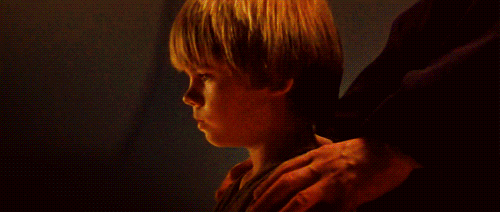
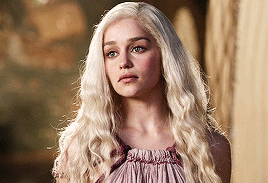
If you’re not familiar with Vader’s story in Star Wars (but how tho??), protagonist Anakin Skywalker started out as a poor, innocent slave boy who happened to have a very strong connection with the force. He’s even assumed to be the “Chosen One” from the prophecies that would balance the Dark and the Light sides of the Force. So he ends up training to become a Jedi with the hopes of freeing his slave mother whom he left behind in Tattooine, his home planet.
Eventually Anakin grows up to be a good but slightly arrogant teenager who is manipulated further by Emperor Palpatine (who’s posing as a good guy in the Senate). And because he’s fully aware of his natural talent, he’s even pushed further by the fact that the Jedi Council does not fully acknowledge his merits when he deserves them. One of the key moments in his transition is when he finds his mother murdered, which led him to his first act of madness when he massacred the tribe that stole her away.
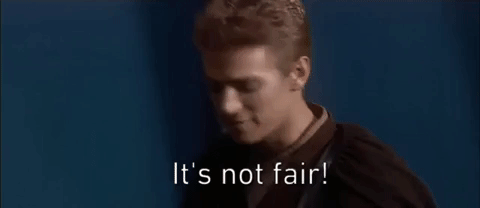
But the final straw was when he dreamt that his secret wife, Padme, might possibly die through childbirth. This made him seek even more power to save his wife and unborn child, of which he was unable to do with his mother, and it eventually blinded him from seeing the good that his comrades and loved ones were trying to do to help him.
At this point, he concluded that by being the most powerful, most fearsome Jedi on earth, he can prevent every terrible fate that could happen to the ones he loved. So he helped the Emperor massacre the whole Jedi Council, including the innocent children, in order to be stronger using the dark side of the Force. And you know the rest, his wife died in childbirth, indirectly because of his actions, and thinking that his mentor and brotherly figure Obi-Wan betrayed him and left him to die, he eventually became reborn as Darth Vader, now completely overwhelmed by hatred.
And it’s not until the last minute when Luke, his son with Padme, helped bring him back to the Light when Vader chose to protect his son with his life instead of letting Palpatine kill him, ultimately fulfilling his prophecy as the Chosen One.

See the pattern here? Daenerys seems to be following quite a similar path, with her initially being a poor, helpless girl with a very tough upbringing who eventually gained power to protect the common folk. Not only that, but she also has something to do with the “Azor Ahai” Prophecy about the “Prince/Princess that was Promised”, although whether or not this means her, Jon, or their future child is yet to be seen.
Unfortunately, just like Anakin, Daenerys has been shown to have lingered in between the light and dark at times, such as burning her enemies or using fear to bend people to her will when her patience runs out. Of course I won’t deny that some of these actions are considered necessary considering that some of her enemies don’t do well with peace pacts or respectful discussions, most especially when they go through lengths to disrespect her as a woman.

But as much as I love Dany, I can’t deny that some of her actions, regardless of where she came from and how she came to be, are not doing her any favors with the Westerosi. Like Anakin, she has been slowly losing sight of what has been her main goal in the beginning of her pursuit; to save the people who suffered like she did and to find a place to truly call home. Now most of her focus is gaining her right to the Iron Throne, while slowly losing bits of emotion here and there especially when betrayal hits her at one front to another.
That is, until dear honorable Jon Snow came along.
Just like how Anakin and Padme’s forbidden love story ended up changing the Jedi forever, Jon and Dany’s love story seems to be a must in breaking the wheel of the current world, not just in politics, but the fate of the world itself. After all, Melisandre has prophesied that both of them have a very important role to play in the Azor Ahai prophecy in stopping the Night King.

Whether you ship them or not, you can’t deny that these two were bound to have a special connection thanks to their parallel journeys and their secret Targaryen relation. It’s interesting to note that in the beginning, all that Jon ever wanted was to become acknowledged as a Stark, arrogantly thinking that he had it worse than everyone else. Now that he’s constantly given all these burdens and high positions, he’s become more humble and doesn’t enjoy being the leader that people turn to.
Dany, on the other hand, was a meek and afraid little girl, having no idea in the beginning that she was capable of becoming more, no thanks to Viserys’ abuse. But as time went by, she began to grow as her own person and became more and more powerful, which unfortunately led her to become quite arrogant at times.
While Jon’s been shown to have a harder time killing more and more people out of duty, especially when he began to realize that not everything is in black and white, Dany has been shown to be having an easier time disposing people who defy her, even the ones who used to be on her side. It’s not to say she hasn’t tried doing things the gentler way, but a lot of if not all the peace talks she’s attempted with her adversaries have never really gone smoothly. Not to mention, most of the people she had placed her trust in in the beginning have either betrayed or left her at some point.
To be fair, we can’t have two exact copies of “Jon Snow” in the GOT world. That wouldn’t make much of an interesting story now can it?
With that said, it seems possible that Jon’s role in GOT is quite similar to Luke’s trope as the reluctant hero of the story, the one who saves the whole world by saving their loved one from being completely immersed into the Dark Side.
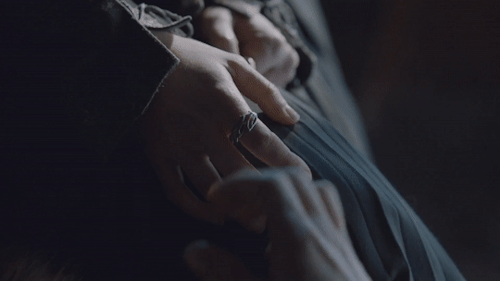
Of course, we haven’t seen Dany turn completely mad just yet, and I personally hope it would never happen. But the first two episodes of Season 8 has compelled me to imagine the uncomfortable possibility of what it would be like if Daenerys does end up becoming a villain. Her thirst for the crown has been focused on too many times to deny in the first two episodes of the final season, and it seems that not even her love for Jon would let her set aside her quest for the crown completely, at least not yet.
But there’s also a possibility that their future child, if the constant foreshadowing in Season 7 comes to fruition, might also be a strong factor in changing her mindset, just like how Vader’s love for Padme and his children compelled him to eventually turn away from the Dark Side. Most importantly, their child might also have a huge role in stopping the second Long Night from happening, however possible that is, if he/she/they have something to do with the prophecy.
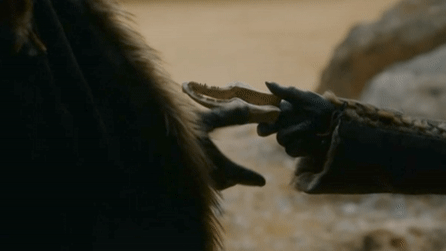
Another interesting possibility that’s been pointed out by some fans is that the only person other than Jon that might stop Dany from her road to Mad Queen status is the woman who currently checks up all the boxes of said status.
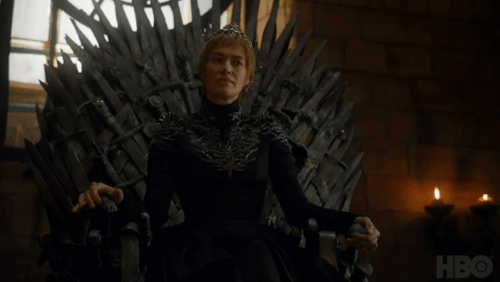
Cersei may not have the pure intentions that Dany has, but they do have a common factor of wanting to gain and remain in power no thanks to their past experiences of having their father/brother control most of their lives in the early parts of the series (Tywin with Cersei, and Viserys with Dany). I’d personally wager that Dany is still far from Cersei’s “Mad Queen” level, because at the very least Dany still has a few good and true comrades to help keep her feet on the ground. As Tyrion told Cersei, at least Dany has enough brains and empathy to listen to their advice at times, whereas Cersei would never do so unless it benefits only her.
This Cersei-Dany parallel would be a pretty similar situation with, again, Darth Vader and Luke. Just when Luke battles with his father and was almost on the verge of killing him, he stops when he sees his father’s robotic hand, realizing how similar they actually are and how much the Dark Side has affected Vader in the worst ways, which he himself almost fell into if he didn’t see the truth with his own eyes.
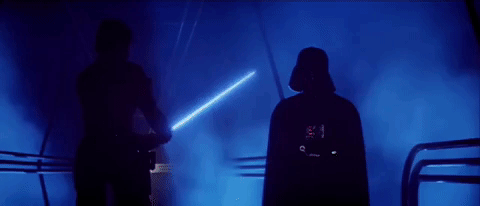
After the Battle of Winterfell is over, and Daenerys sees the remnants of the Night King's power while also coming to terms with Jon’s status as the rightful heir, perhaps Dany might reconsider and reflect on her true purpose in attaining the Seven Kingdoms. True there's also a huge possibility that she'll turn even darker than before, especially if her close comrades die/leave her, leaving her feeling more alone and out of place. But perhaps after seeing Cersei the way she is, with no true friends, no family, and no love left in her except the crown on her head, this might lead Dany to see the hard truth; The Iron Throne isn’t worth her humanity.
With that said, whether or not Dany turns into a true antagonist is yet to be seen. Contrary to some fans' predictions of her dying in the end, I actually believe that she'll survive, but not without huge consequences of course, which is carrying the guilt with her for the rest of her life. For some people, continuing to find the will to live can be much harder than dying a quick death.
Having her killed off easily as a villain without redemption or in childbirth for me is a very big disservice to those who have watched/read her whole journey since Season 1 and the 1st book. I doubt that George R.R. Martin created Dany only to make her a Cersei 2.0 in the end. It would be the such an injustice for the series to conclude with Dany’s faults completely overshadowing the many good things she has done for the ones without power, especially during her time in Essos.

We have yet to see how low Dany would go to seize power as Vader would, and I’m extremely worried about how much it would affect everyone’s view of her till the very end, especially as a character that was so beloved for the whole 7 seasons, only to have her hated by most without proper redemption at the final season. Yes, as a GOT fan I’m glad that Dany’s being given a wakeup call that her idea of ruling has its flaws and does not suit everybody. But if she is really meant to betray Jon and the rest, I seriously wish that whatever payoff the writers have for Dany will be worth it in the end. Especially when there’re only a handful of episodes left.
And if people really think that Jon would easily leave Dany just like that, then boy, have they not been paying attention to Jon’s character development. Jon has already chosen duty over love several times, with one of those choices leading indirectly to his first love’s death. I highly doubt that Jon would ever leave Dany alone like that, even with all her faults, especially if she’s with child and if they do get married even if out of duty.
Just like how Padme never stopped believing that there is good in Anakin till her dying breath, it’s in Jon’s persona that he would do everything in his power to keep Daenerys from falling completely into the dark and feeling alone. I won’t be surprised if Jon would choose to take the fall for/with Daenerys if she is to be punished for whatever wrongdoing she’s about to do. That’s just the type of guy he is.

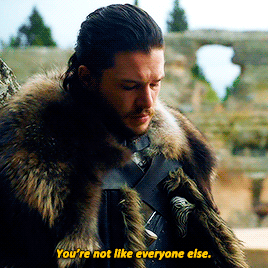
With that said, we have no choice but to wait until Episode 3 and 4 to really see where Daenerys’ morality will be going. As with every season, with every new episode that comes out, anything is possible. I still hold onto the hope that the writers know exactly what they’re doing with Daenerys and that it’ll be true to what George R.R. Martin really intended for her, although I’m already a bit wary at how they’re currently handling her responses. If her path is to go the same way as Vader’s like I guessed, I can only hope that they can do enough justice to make her memory worthwhile.
If not... there’s always hope for the books. And fanfiction.
#daenerys targaryen#a random thought#darth vader#got#got spoilers#game of thrones#jon snow#jonerys#star wars
17 notes
·
View notes
Text
some uhhhh.....thoughts about asra & his route.
alright, listen....i wanna love asra i rly do i rly rly do but wow this route so far is making me just ' >8T ' over and over i'm grinding my teeth over some of this and it's driving me nuts. like, julian's route has absolutely ruined me for this, i'll be real here, but also....even if i hadn't played him first, i think this would aggravate me??
please god don’t click this cut if you’re not ready for some salt and side-eyeing and a LOT of speculation.
soooo....asra keeps withholding information and saying he doesn't think MC is ready and then literally confesses to wiping MC’s memory?? esther is sweet, but she's not the most trusting. ( i’m using her for a lot of this just because honestly she’s my POV for headcanons with this game ) she wants to trust asra, but this is all putting her on edge. she DOES have feelings for him, i won't lie about that; like starting out i think she does have feelings for him in any of the routes and she wants to know him better--but then me personally? lines like 'oh you always get into trouble but i always come to help you' when asra knows she has no memories of things like this and has that power over her....that's putting me off. he knows more about her than she knows about herself and it feels...icky...for him to be feeding her information like this. he’s placed himself in the role of her teacher/master so that gives him authority over her--you’re supposed to trust teachers, feel safe with them, and so esther would have no reason to think ‘oh he’s not being straightforward with me about things’ and that just really skeeves me out. i appreciate that asra loves her, and that he's been trying to take care of her and keep her safe, but this is the other side of that: when someone is trying so hard to keep you safe that it turns into just coddling and worse, grooming.
and then there's the fact that he's been withholding and even DELETING this information from her--he's literally told her he erased her memories of struggling to remember things, and like...dude what? then he says 'well maybe i needed help to make it work' like uhhhh....so then in all of that time if you really wanted her to remember, why not talk to her? why not try and explain that this could be painful and hard but the situation is what it is and she could help him make it right--why wait until she's literally got you in a corner over it?
julian and esther were on equal footing. they were both confused, both missing memories, both struggling with things they didn't know and wanted to understand, about themselves and each other and this situation they found themselves in. they came together to help one another, and they grew together, and fell in love together. they fell in love without those memories, without the past to help or hinder them. they were blank slates and they still chose each other and realized they loved one another--and when they found out the truth about their past they still chose to grow from it. it was all equal, it was all mutual and earnest and open. they talked about their feelings. they help one another become better, stronger, and they evolve together. it's not one fixing the other or one becoming better than the other.
but with asra...he's keeping you in the dark literally to suit him? like that's how this comes off, 'don't remember so i can keep you ignorant and safe with me, because that's obviously what's best for you' he holds the power. it's a huge imbalance and he keeps. feeding. into it. 'if you remember too much it could damage you beyond repair' 'i did it because i didn't want you to be in pain' 'i'm always there to save you' he's making it so you rely on him and i'm....repulsed and fascinated by it. like that's some heavy manipulation stuff, and playing a character like esther is making me really have to confront like 'maybe i personally see through some of this but would she...?' and i don't wanna just let her fall into that, but if she'd never gotten involved with julian then she'd still be pursuing the feelings she had for asra, and she might really believe all of this and trust him about it :/ like.....even more so when she finds out in this route that asra is the one who brought her back to life, that’s.... > falls in love with girl > girl dies > brings girl back to life > for whatever reason, keeps past from girl until cornered into answering there are a LOT of gaps to fill in there, but like... the fact that asra brings her back to life and then won’t tell her anything and is really pumping the breaks on her remembering things makes me incredibly uncomfortable with him as a love interest. and like...imo that reads like ‘asra fell in love with esther/MC, they didn’t love him back, they died, and he brought them back to life and then coddled them and hid their memories of their past from them in the hopes that things might turn out differently this time’ which is really a pretty classic/common romance trope....if asra was the antagonist. and this is me just spitballing but if you don’t want someone to remember things, people, then there’s...usually a reason for it. so in this instance, especially given the events during the plague and his anger at julian for your death, it kiiiiinda feels like it’s leaning towards ‘MC was in love with julian instead of asra and asra didn’t want MC to remember that’. take that as you like.
and like, beyond all of this, i still do like asra as a character! like, objectively he’s fascinating. fun fact about me: i’m coming to this fandom from the star wars fandom, and like...legit, first thoughts i had about asra when i started his route: ‘holy shit he’s just the arcana version of anakin skywalker’ and like, imo, that’s not a BAD thing--i loved anakin and i do like asra, as much shit as i give him. plus, the chance to use some anidala parallels is always fun--but is that a healthy relationship model...? no. so i’m hoping you can confront some of this further into asra’s route and maybe get some answers and some real talk in with him about all of it, but right now i’m just like wow this is. not what i was expecting given how much the fandom seems to adore asra. ( then again i’m fresh from fandoms where people either love or hate this kind of character so my reaction might be more surprised than it ought to be. )
4 notes
·
View notes
Text
An alternate possibility behind the #FN2187 post
I’ve been thinking too much a little more about the picture of John’s hands from the Episode IX set, and specifically trying to think of possibilities other than a Stormtrooper uprising because it seems a little too good to be true that John is allowed to hint at major plot points so soon. I still hope an uprising is coming but I don’t want to be married to the idea, and even if it happens it won’t be the only major event in Finn’s story.
One possibility suggested to me by an uprising skeptic (whom I am, in fact, married to) is that this was a scene from Finn’s past, such as a flashback, that helps put into focus Finn’s decision to leave and his current resolve to fight.
I think we can rule out that possibility, though. Even aside from the fact that SW is not known for extended flashbacks and such a scene is hardly the groundbreaking sequence suggested by John, TFA and BtA together made it clear that Tuanul was Finn’s first engagement as a Stormtrooper and his last. There was nothing in his training or his mission to the mine from BtA that would have made his hands look like that, not least because he was either in computer simulations or wearing full armor. Even a flashback to Tuanul would not have covered his hands is soot, given the armor and gloves.
Hold that thought. Tuanul?
It’s well known that the EpIX crew filmed at Wadi Rum in Jordan last year. There have been speculations about what the fictional location is, with candidates including Tatooine, Jedha, and of course Jakku. It could also be a new planet altogether, of course.
I think it’s clear that of all the possible locations raised so far, a return to Jakku is the most emotionally resonant and would do the best job of tying up loose ends. Not only is it the setting of major events early in TFA, it’s also the place of major Imperial/Force-related setup in extended materials. It would be perfect place to return to, much like Luke and to an extent Leia returned to Tatooine in Return of the Jedi, if without the emotional resonance to show for it. Anakin also returned to Tatooine in Attack of the Clones to terrible tragedy. If Jakku is built up to be the Tatooine of this trilogy, we’re due for a return in IX.
Another possible narrative parallel: Returning to the desert planet they couldn’t wait to leave (”There's nothing for me here now,” “I hate sand”) was also the occasion for the protagonists of the two previous trilogies to further their connections to and destinies the Force, by revealing himself as a fully-realized Jedi in Luke’s case and by falling further into despair and violence in Anakin’s.
If the action returns to Jakku in IX, and more specifically to the ruins of Tuanul at some point, we would see Finn revisit the sight of his trauma and his life-changing, world-shaking choice to leave the First Order. It’s also worth noting that Tuanul looked like this the last we saw it:
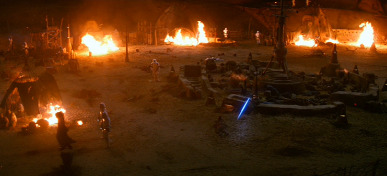
Its ruins would be full of charred buildings and ashes--exactly the kind of substances that would make Finn’s hands look like the ones in the picture, this time without the gloves getting in the way. Could he have fallen, for instance, and gotten the mess on his hands? But what could have prompted that, and in such a spectacular way as John described?
Another piece of the puzzle: I think it was @fuckyeahrebelfinn who guessed that Adam, and thus Kylo Ren, was also in Jordan and therefore whatever Episode IX location it stands in for.
So what if Finn revisits Jakku and Tuanul for some reason at the same time Kylo Ren does? Tuanul was a Church of the Force community and perhaps there is a Force-related plot reason, in addition to all the other weird stuff going on in Jakku. He and Kylo might reprise their staring match from TFA, except this time it’s likely to be all-out battle, perhaps two on one this time with Rey. Ren might even have one or more of the Knights with him, which would make the fight more perilous for the heroes.
Remember how John implied that the scene where Finn’s hands got dirty was “visually crazy?” What if Tuanul, where Finn by all appearances awoke to the Force and Ren fixed him with that creepy stare, is where Finn’s Force powers awaken and he fights back using these powers? That would explain both the soot on Finn’s hands (the environment was covered with it) and John’s comment about the visuals of the scene (spectacular Force powers!).
Of course, this particular day took place in a studio rather than in Jordan, where I understand they wrapped up shooting long since. This leads me to lean more on the fire/ashes/soot being in an indoor setting such as a Star Destroyer and thus, in combination with the tag, Stormtrooper uprising baby. Still, the purpose of this post was specifically to think of an alternate possibility and I find this one intriguing as well.
3 notes
·
View notes
Text
I'm not saying that Anakin didn't make mistakes. He does make many mistakes. He lies and doesn't trust and cannot overcome his fear but it is unfair to compare his story to Leia's for multiple reasons.
First and foremost, Leia was raised in a loving environment with support from the very start. Anakin was a slave. For most of his formative years, that's going to fuck up a child. And he never got any help for that. He was never taught how to undo that childhood trauma.
Secondly, I can't believe you're holding a 9 year old to the idea that he should have made his own choices. Of course a 9 year old slave would want to get far away from the horrors that he lived. Of course a 9 year old would follow the heroes that he's dreamed about his entire life. Who wouldn't?
But to top it off we learn that Anakin has such an intense connection to the Force that he cannot adapt easily to being around all these people. And the idea that he is The Chosen One is put upon him at a very young age. It makes him an outcast even amongst the Jedi. It's not a wonder that he has a hard time fully embracing them.
So now we've got a former child slave, who left his mother in slavery but promised to come back and save her but never has the opportunity, with the weight of an ancient prophecy on his shoulders and such an intense connection to the thing that binds the entire universe together. Then you add to that Palpatine actively working to undermine Anakin's relationships with the Jedi. To make him feel even more othered than he already does, to make him doubt their care for him and further to keep feeding into the idea that he is meant for more than this.
Again, this does not undermine the problems that Anakin makes. His own responsibility comes in here in the choices that he makes. But he never had the full love and support that Leia did. No open and unconditional affection except from his mother (which was offset with a life of slavery) and with Padmé (with whom he had to keep his relationship a secret).
He wanted to be openly loved, wanted open affection, wanted a family and the Jedi weren't a family. Not in the way that the Organas were for Leia. Leia haha a curiosity to those who were responsible for her genetic makeup but she always had a family. Anakin knew his mother and loved her and was brought along because he was 9!!!! Qui-Gon decided to make sure that Anakin was free to go with them and Anakin was encouraged by his mom to go.
Like any 9 year old, he wanted to make his mom happy. Like any freed slave, he wanted to get far away from the place he was kept. Like any outcast (who remember, wasn't originally wanted by Obi-Wan) he struggles to make connections.
And that's the real parallel between them. Leia was taken from her parents and wanted, desperately, just to be loved and cared for.
Anakin left his family willingly (? As willing a 9 year old recently freed slave who is rescued by their hero can be willing) to go to a people who do not want him at all and then begrudgingly accept him because they think that someday he will do something for them.
The parallel is about the type of people someone can become when given love and affection from the start and being able to chose their own destiny.
Thinking again about how Leia’s whole arc of coming to accept the fact that she’s adopted and doesn’t know her birth parents doesn’t just parallel Obi-Wan’s journey towards accepting Anakin and Padme’s loss, but parallels Anakin’s FAILURE to accept leaving Shmi and becoming a Jedi.
The amount of times we got the Jedi paralleled to the Organas in this show, the acknowledgment that the Jedi were a family to their children just like the Organas were to Leia, hammered home what Obi-Wan lost.
But it also really hammered home what Anakin was never quite able to accept. I know that in the novelization and early scripts, Anakin does call the Jedi his family, but he also consistently feels as though the Council doesn’t trust him, as if Obi-Wan is just holding him back for no reason, and, most obviously, is perfectly capable of just killing them all. And he kills them to save the person he cares about most: his wife. The person who most represents a more traditional family, especially after the loss of Shmi.
Leia feels uncertain as an Organa, she tells Bail in the first episode that she’s not a REAL Organa and sounds so hopeful when she asks Obi-Wan if he is her “real” father.
But by the end of the show, Leia doesn’t need to hear about her birth parents. She doesn’t need to know Anakin or Padme or what traits of theirs she has seemingly inherited. She has a family and she knows exactly how much of an Organa she wants to be, what KIND of Organa she wants to be. She takes after her mother in her discipline and kindness, she takes after her father in her bravery and passion and dedication. Those two people just aren’t Anakin and Padme, they’re Bail and Breha Organa.
And that’s not something Anakin could ever really accept, he never seemed to truly accept the Jedi as his new family. For all that he calls Obi-Wan the closest thing he’s ever had to a father, he gravitates towards Palpatine as a father figure, he can’t let go of Shmi, he obsesses over and fixates on Padme (someone who definitely becomes something of a replacement for the place Shmi held in his life anyway). He can’t let go of his attachment to the idea of a REAL family, one that looked and felt like what he had with Shmi and can’t quite manage to adjust to being a Jedi, part of the Jedi family and the way that looks and feels.
Leia manages what Anakin never could. She parallels his failure and makes it her success. She’s going to change things, she’s going to change the world, and it’s not because she’s a Skywalker or a Naberrie. It’s because she’s an ORGANA.
#anakin skywalker is a deeply flawed character but he also was failed and set up to fail#star wars#kenobi
2K notes
·
View notes